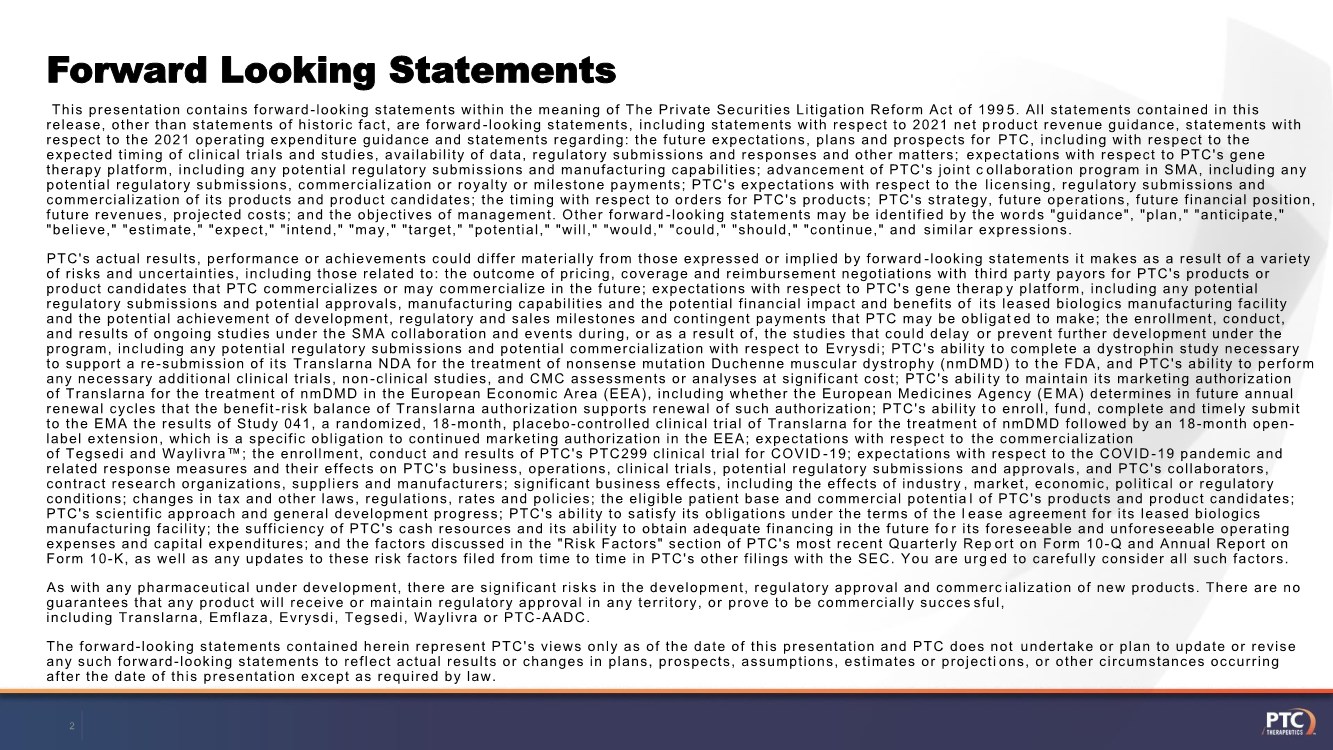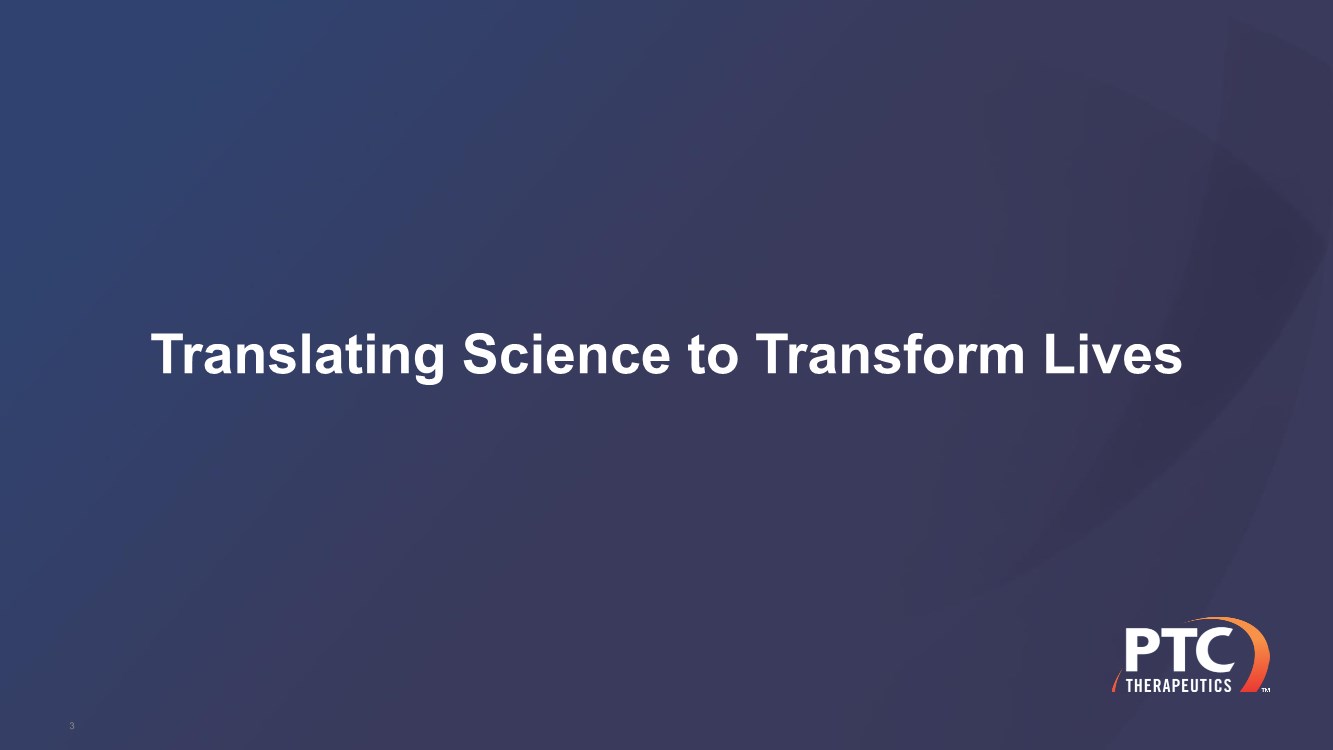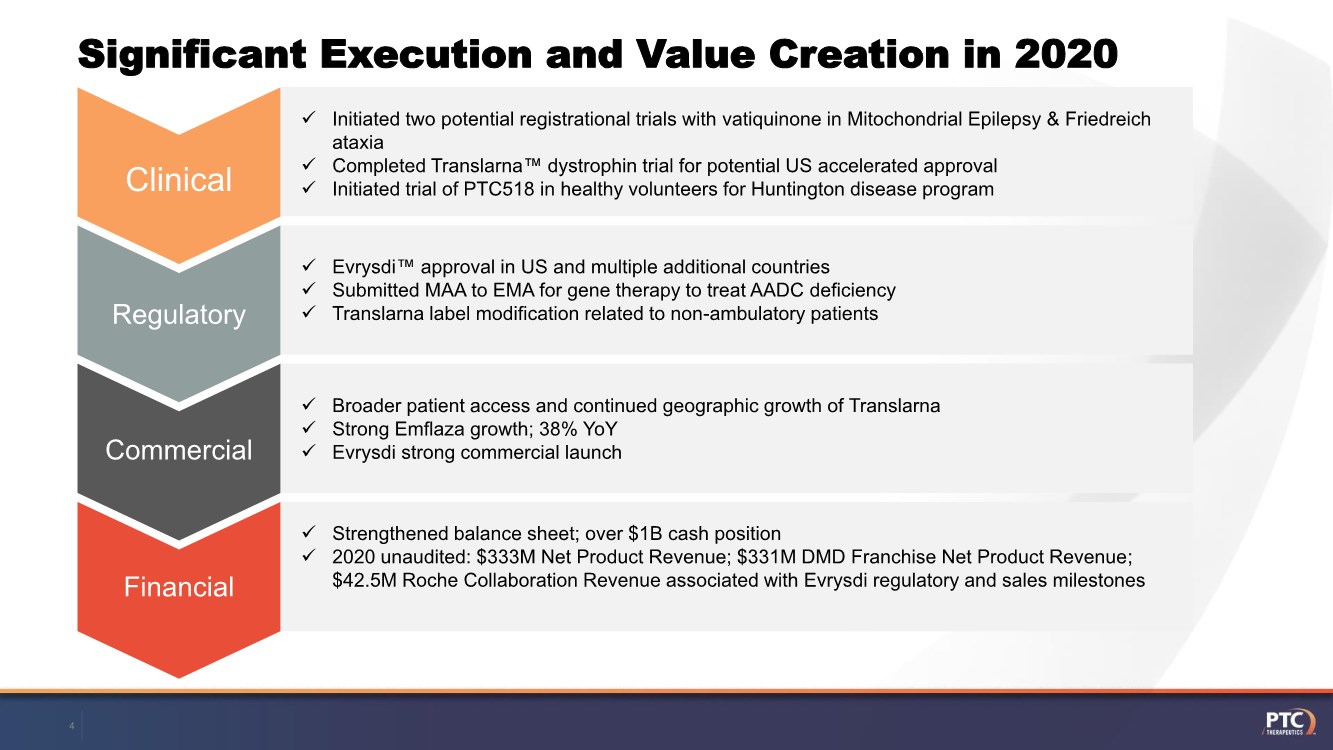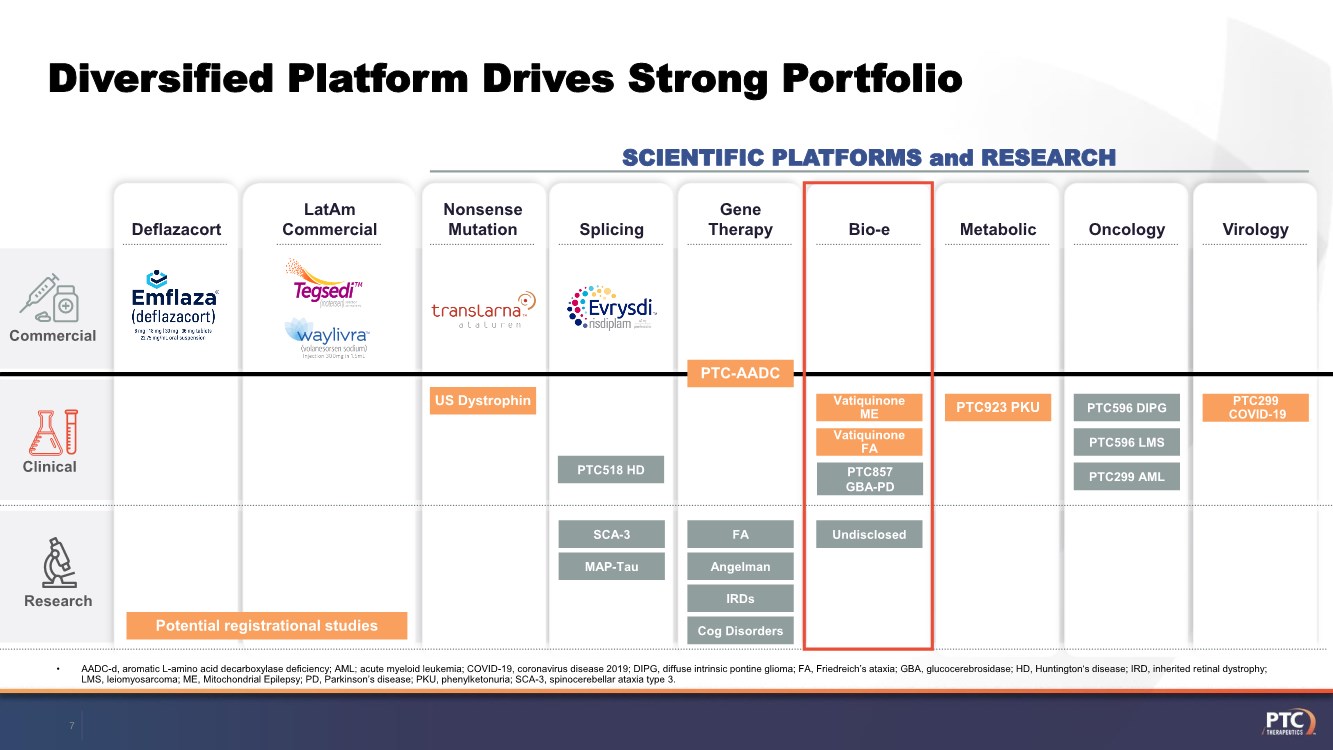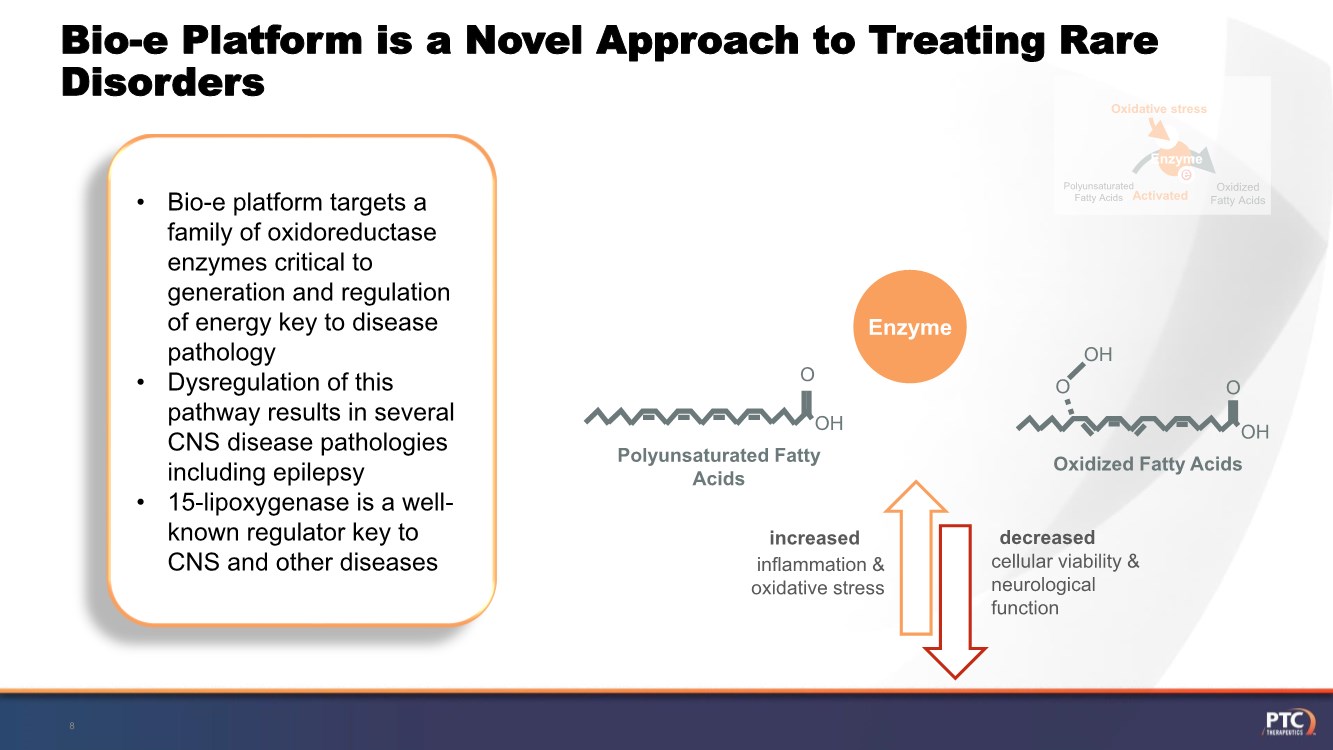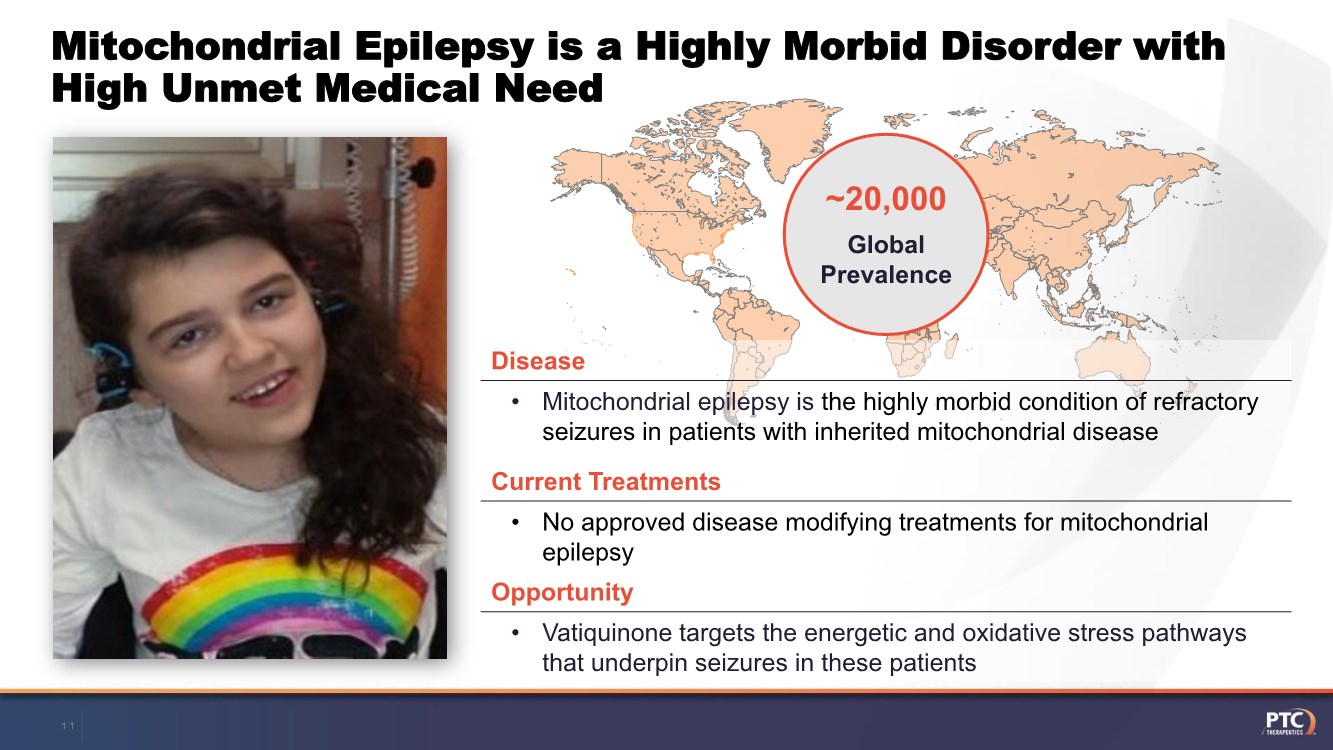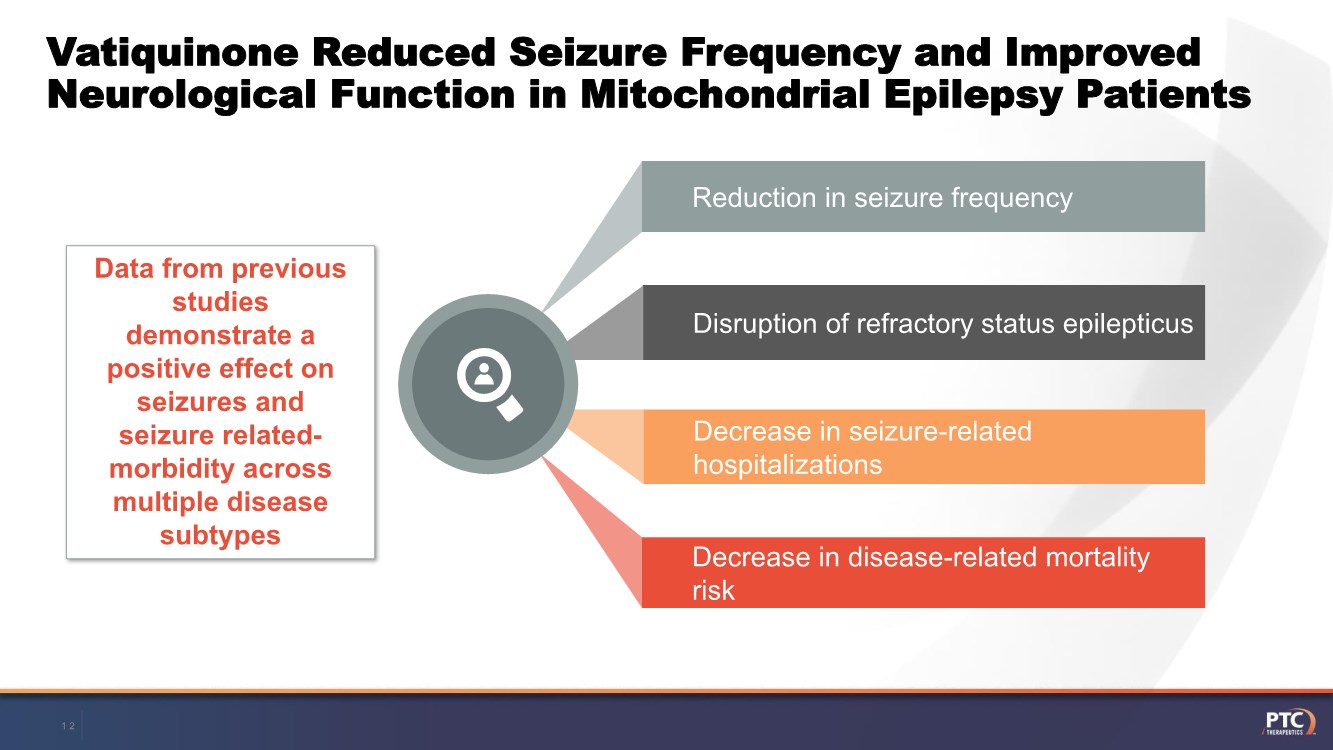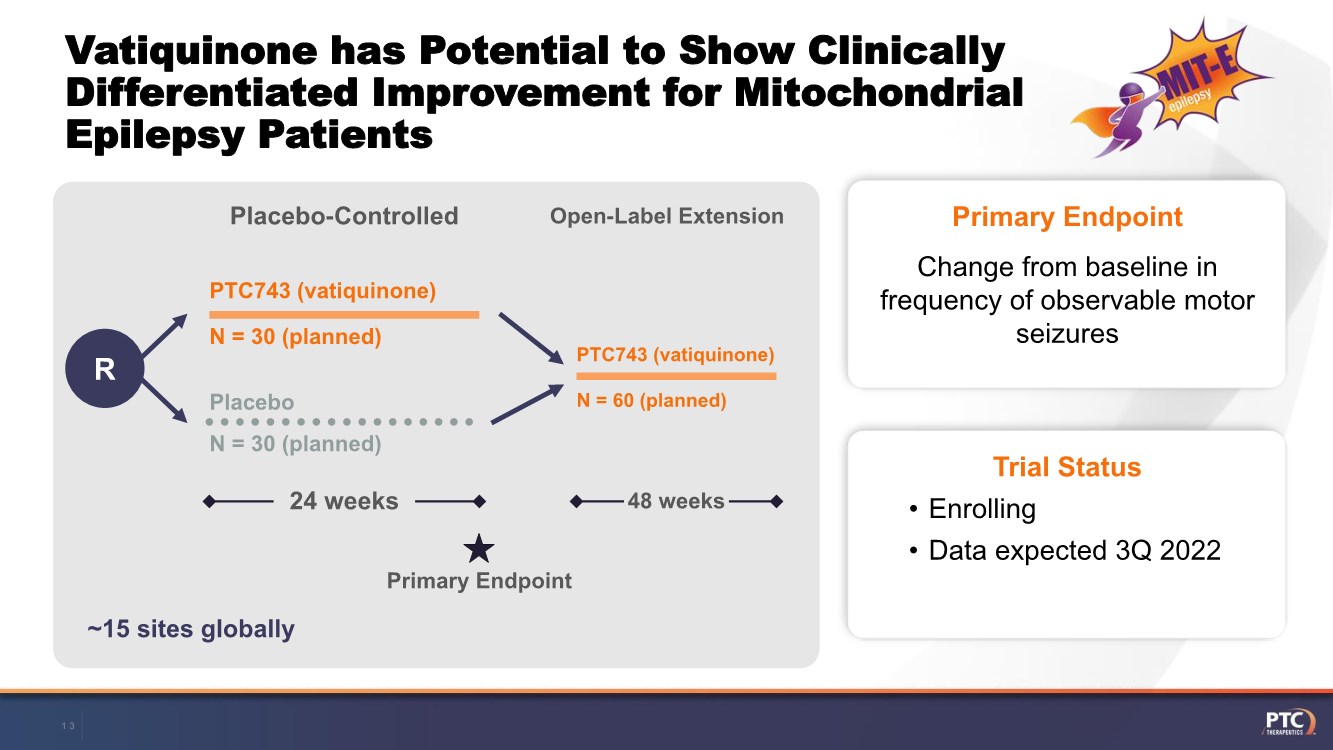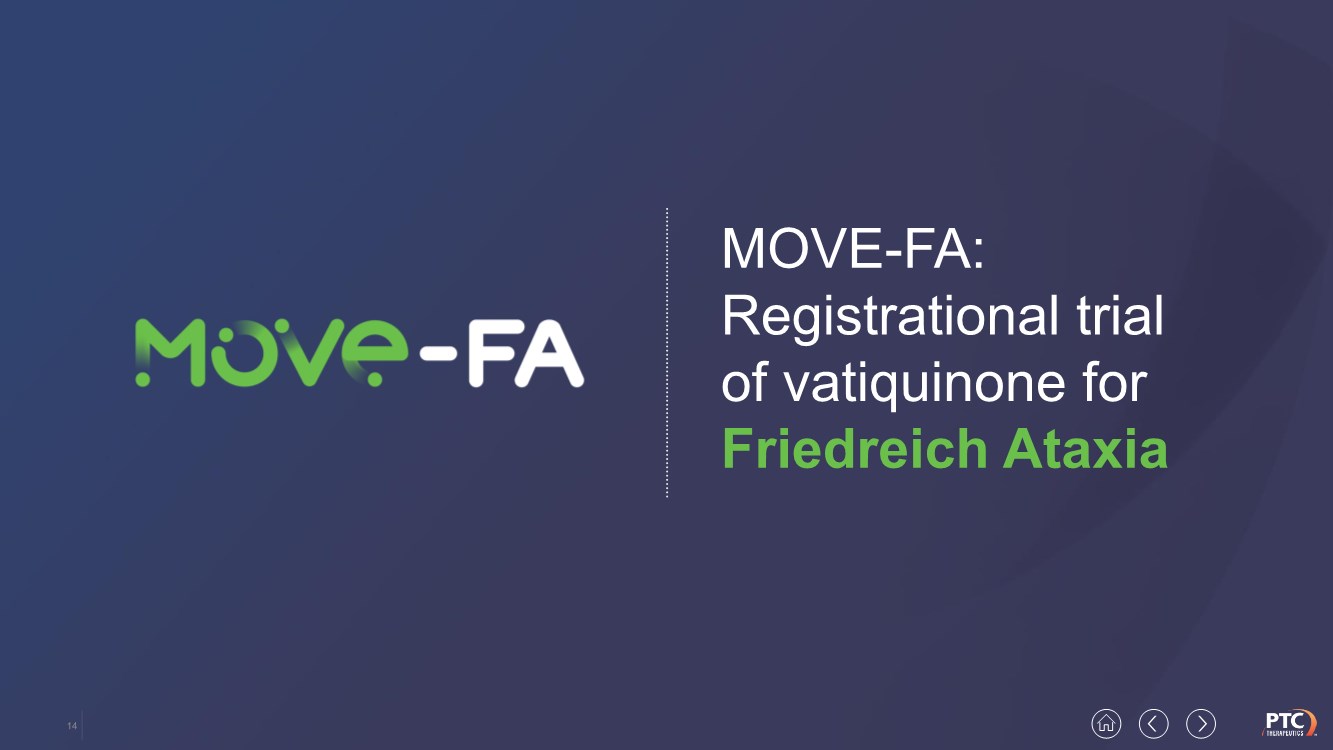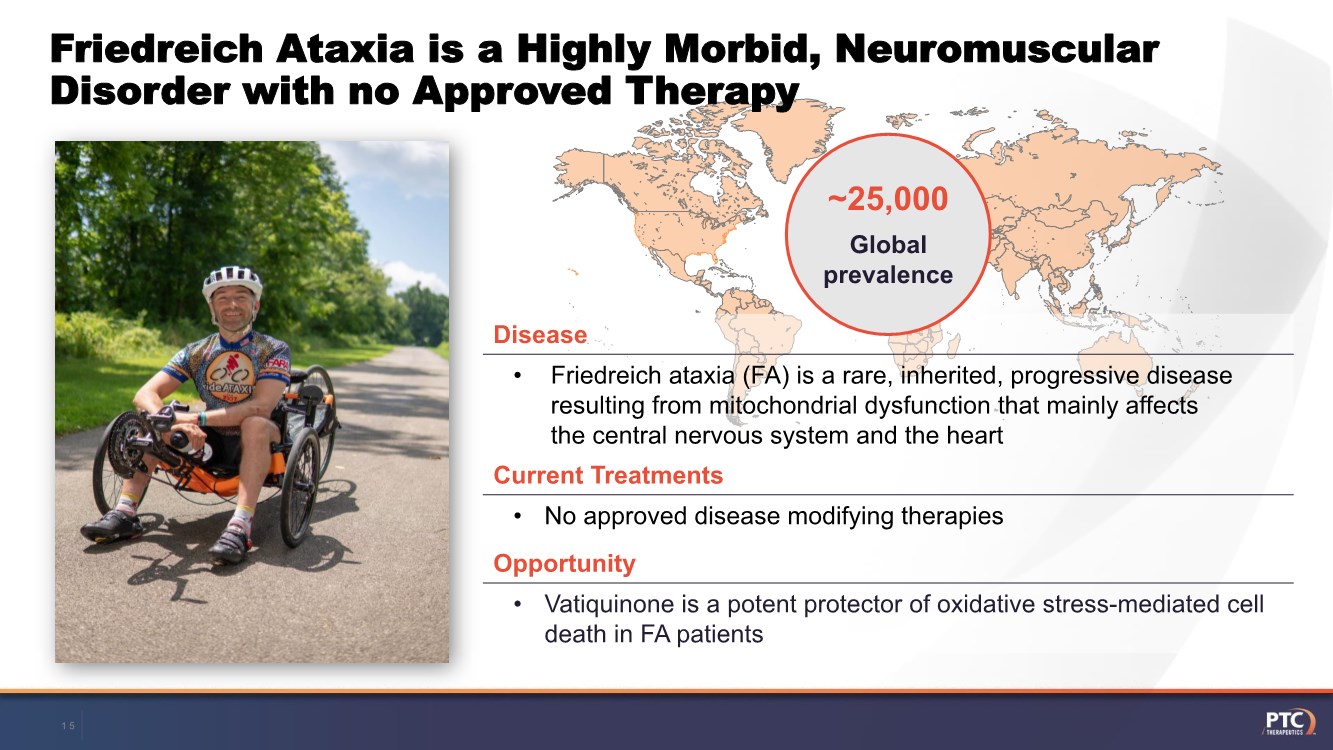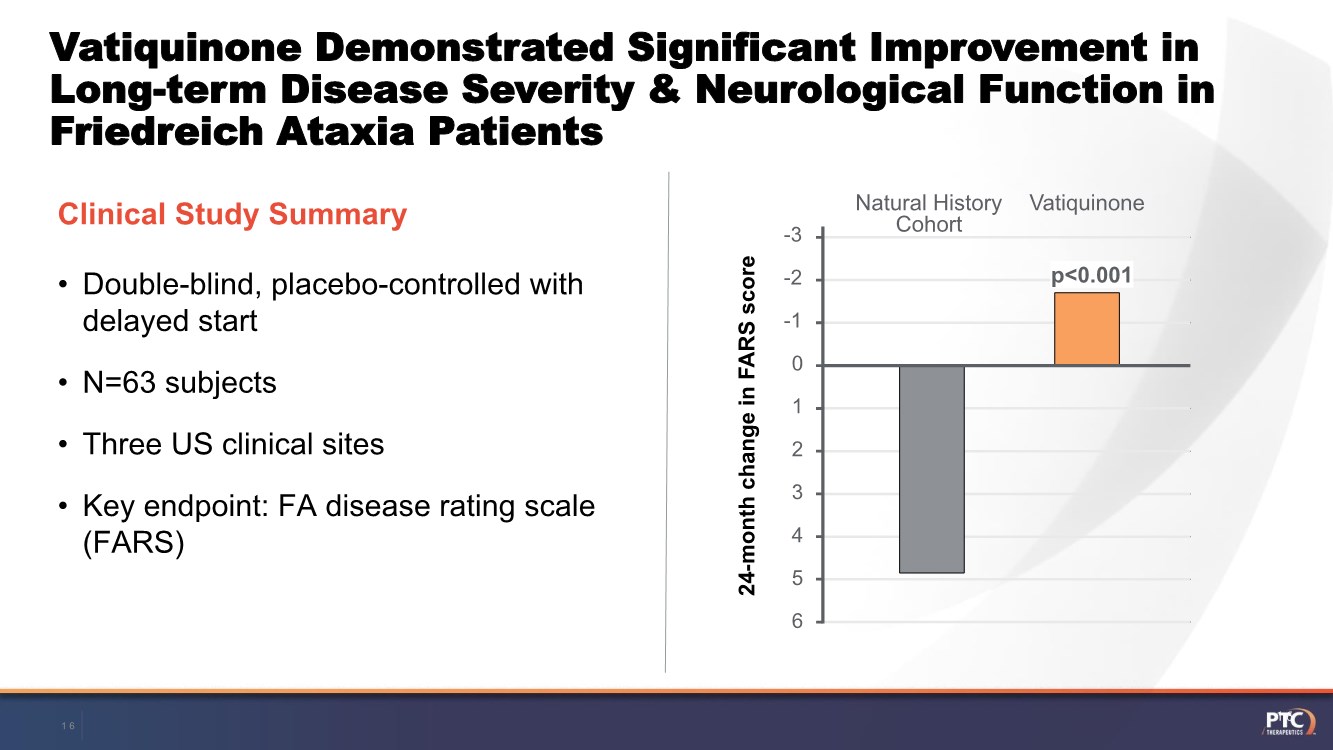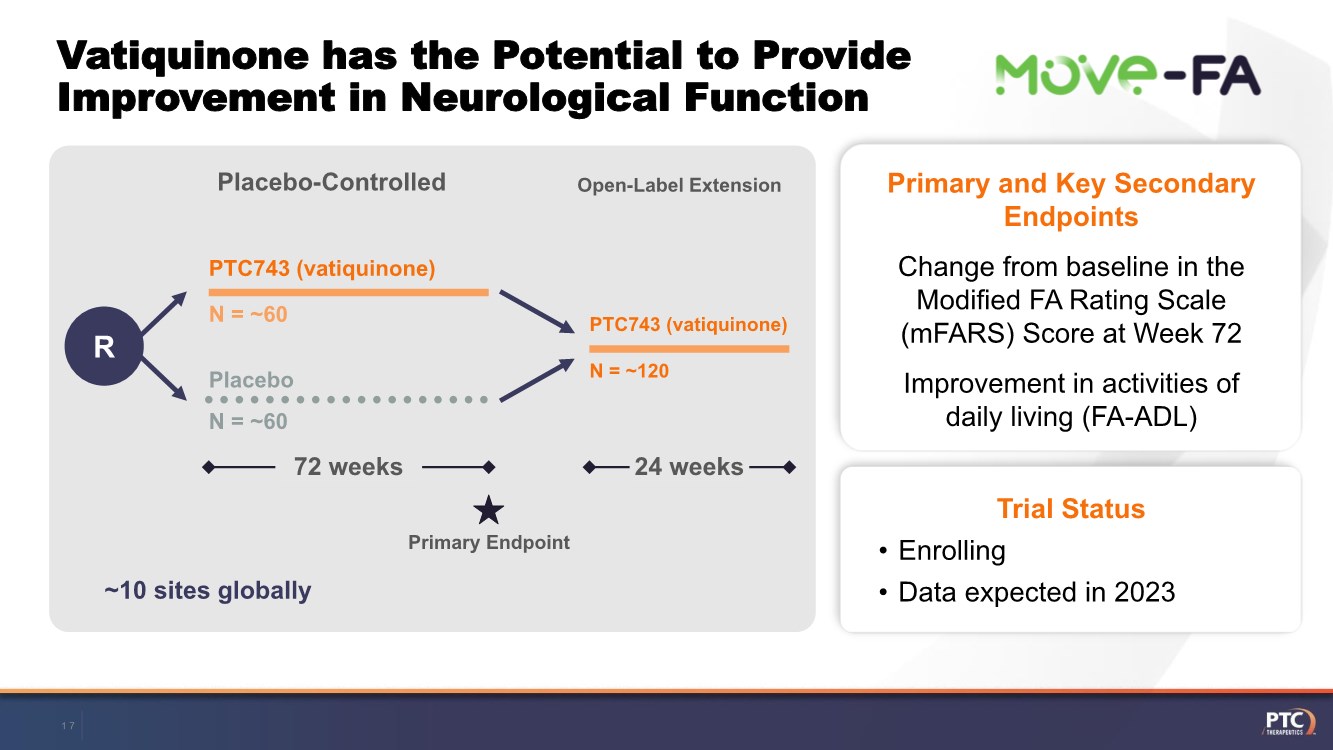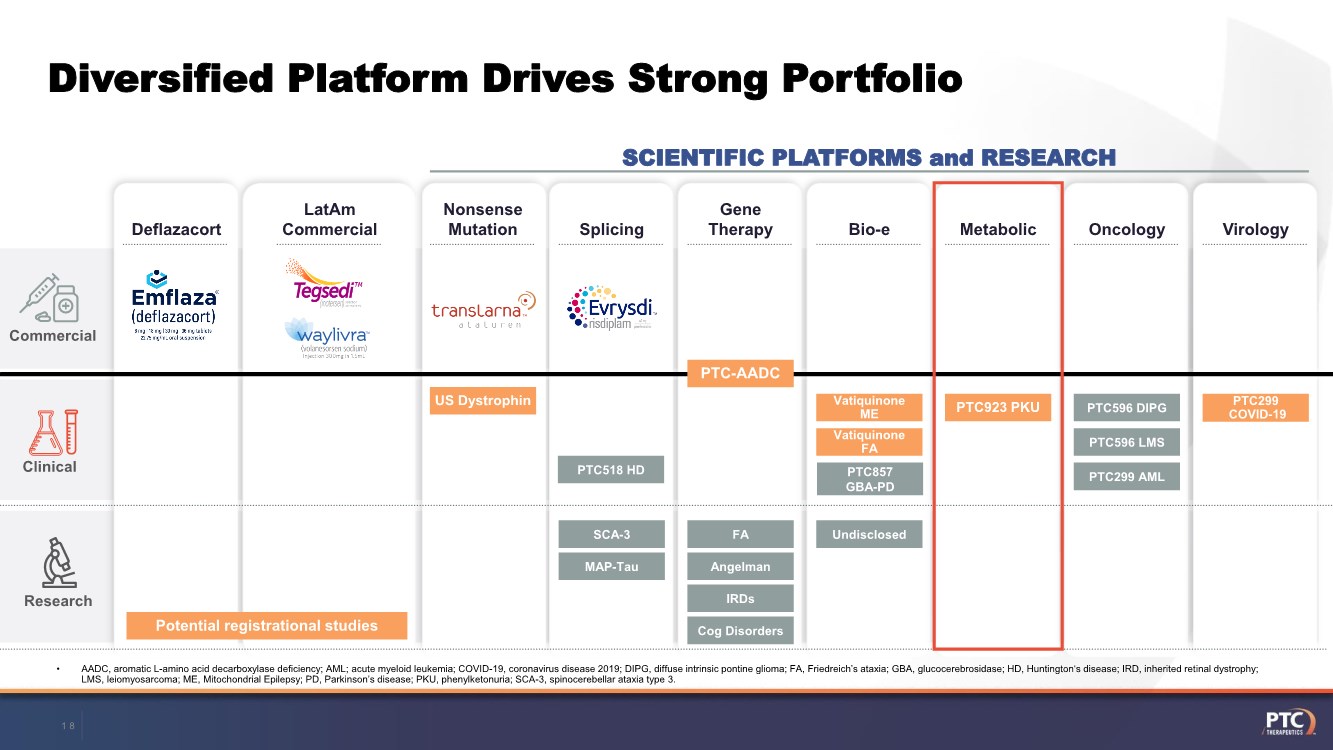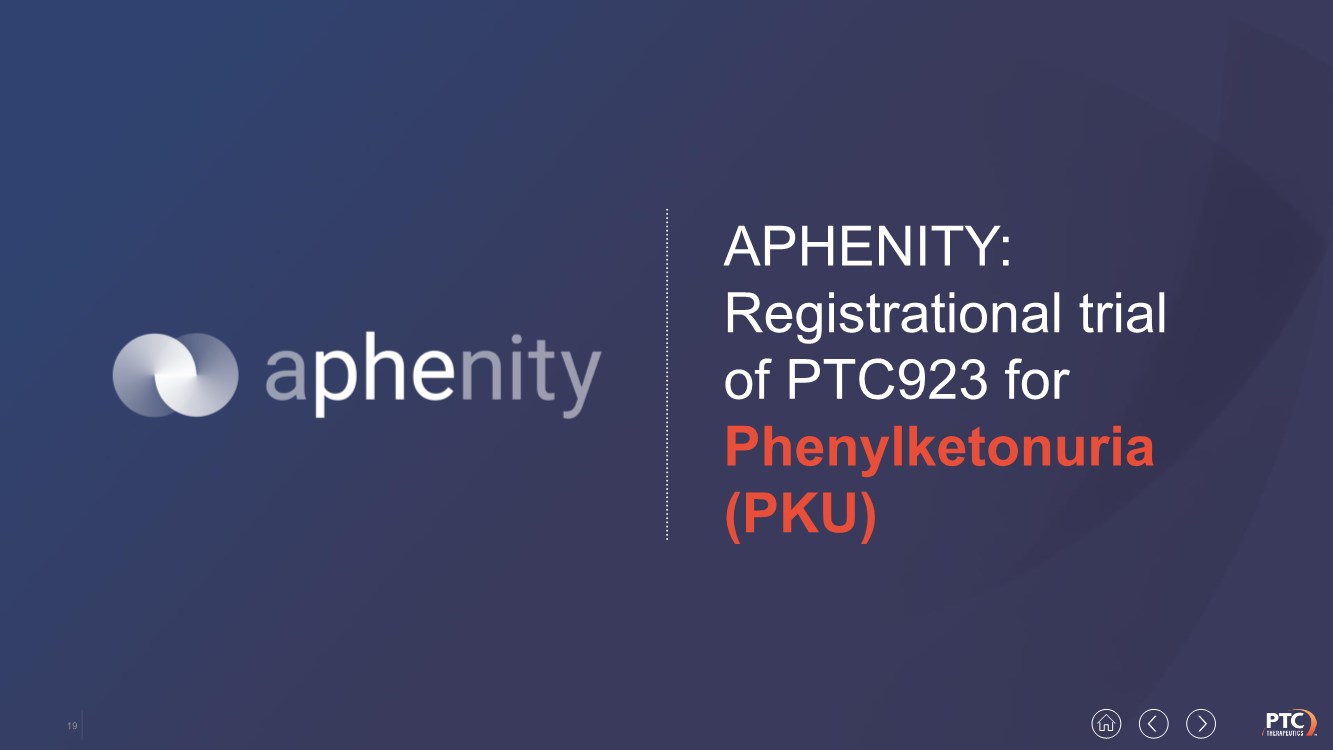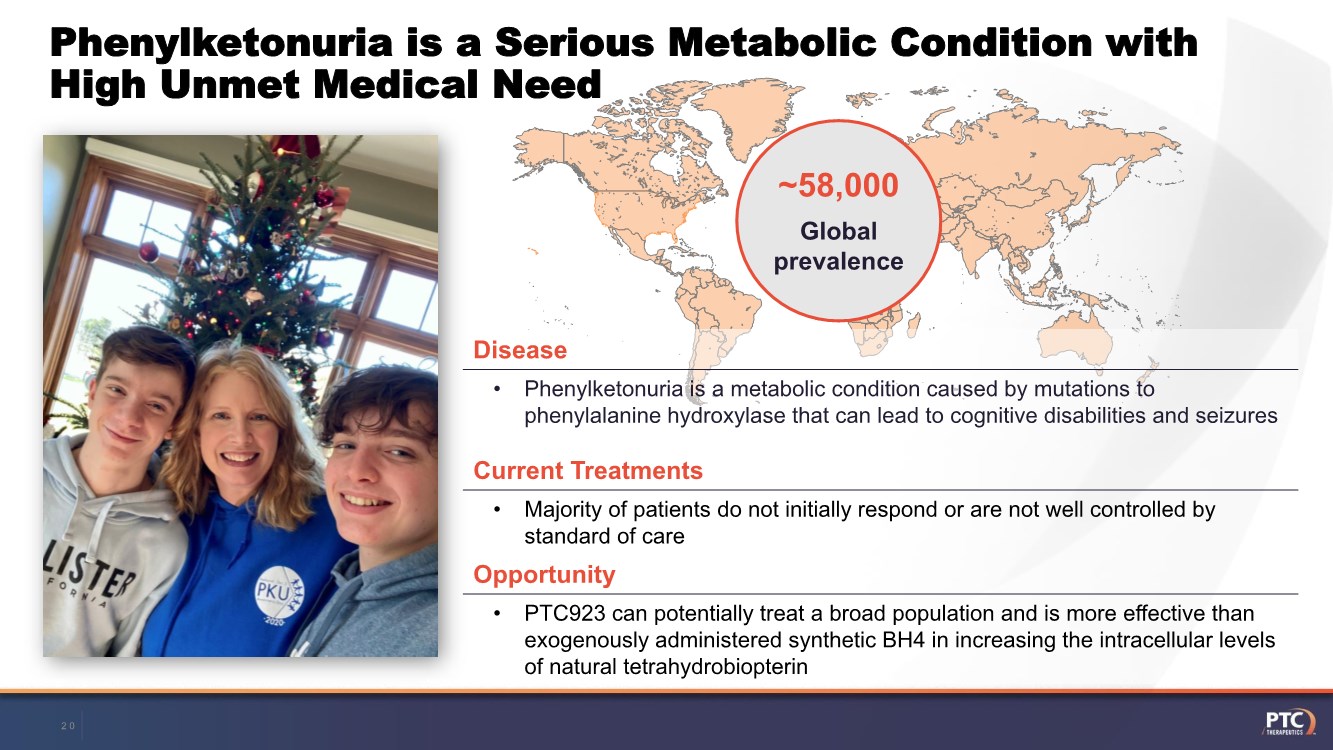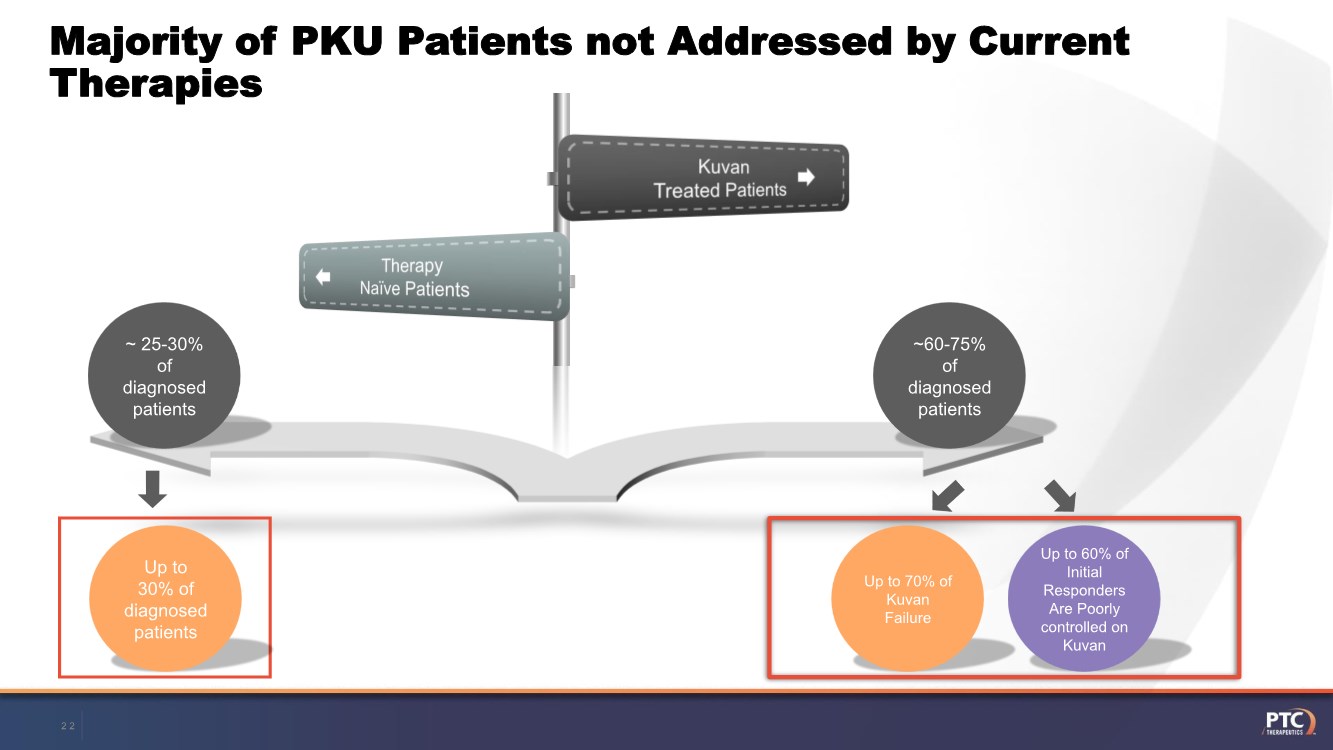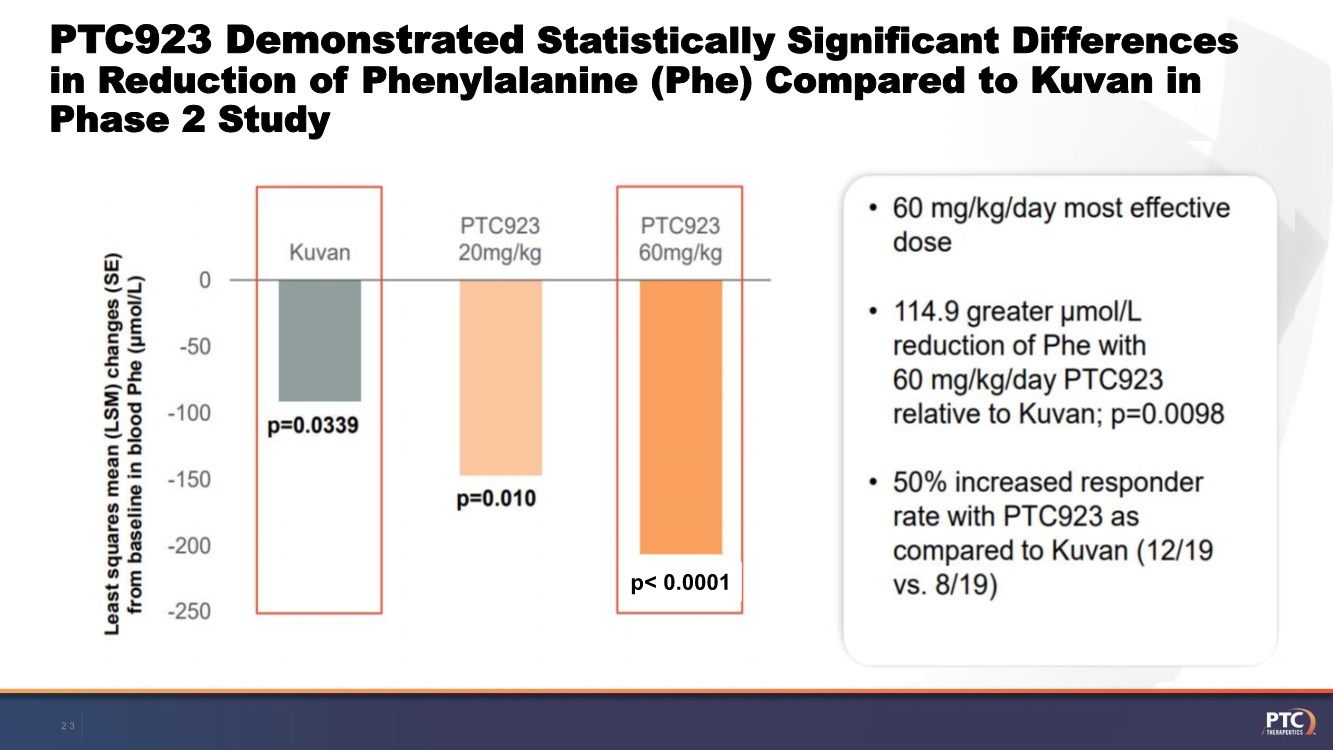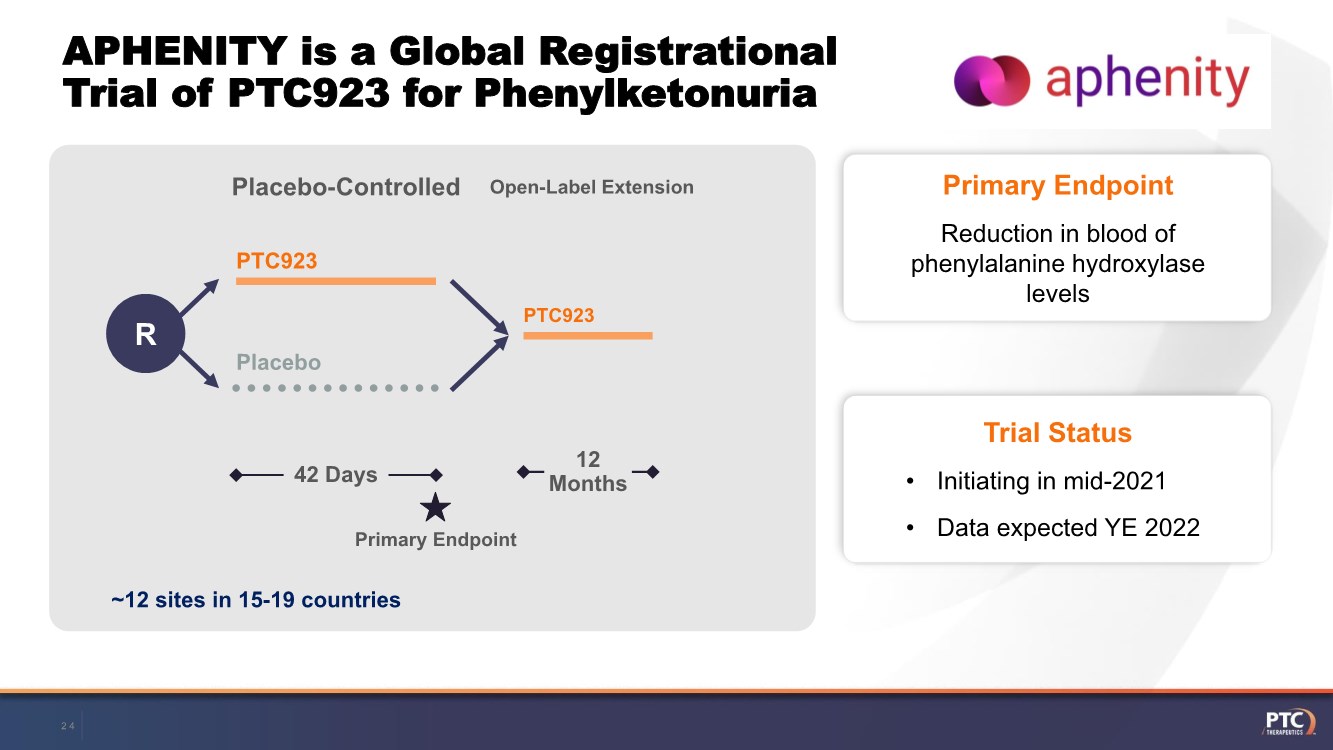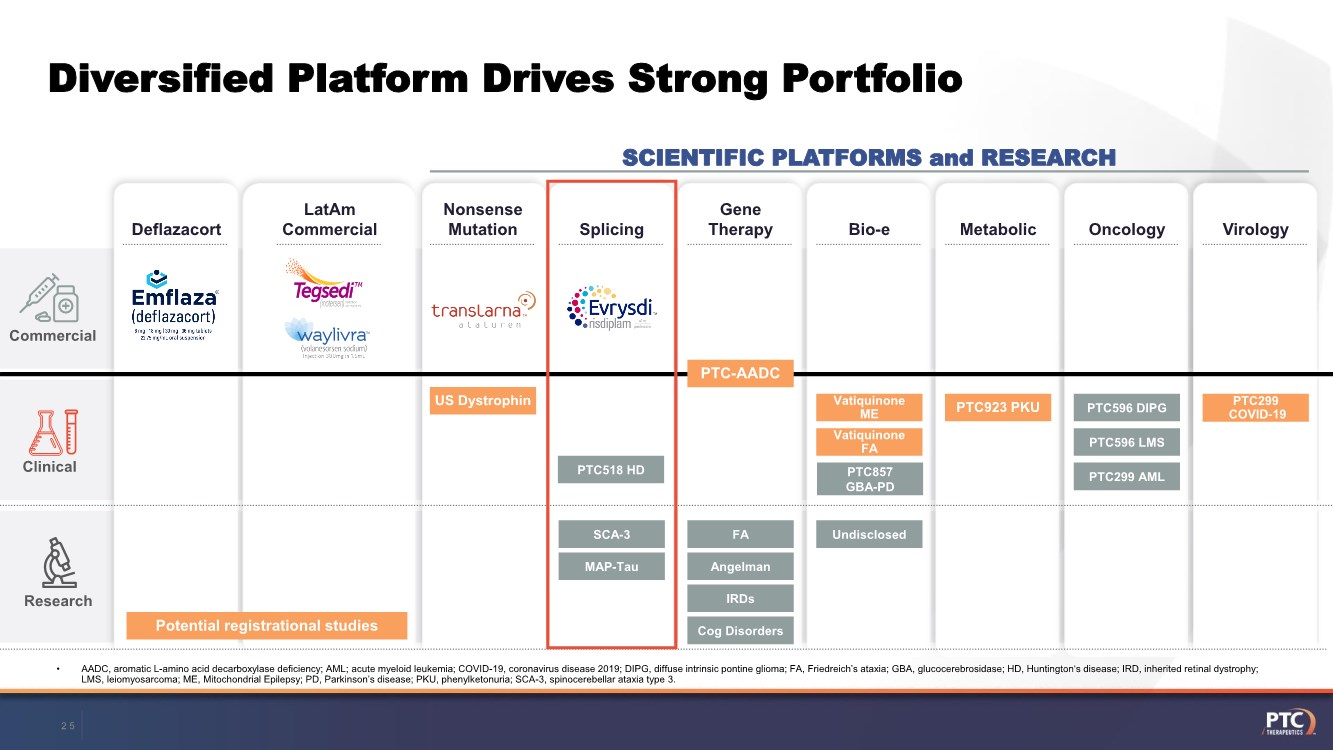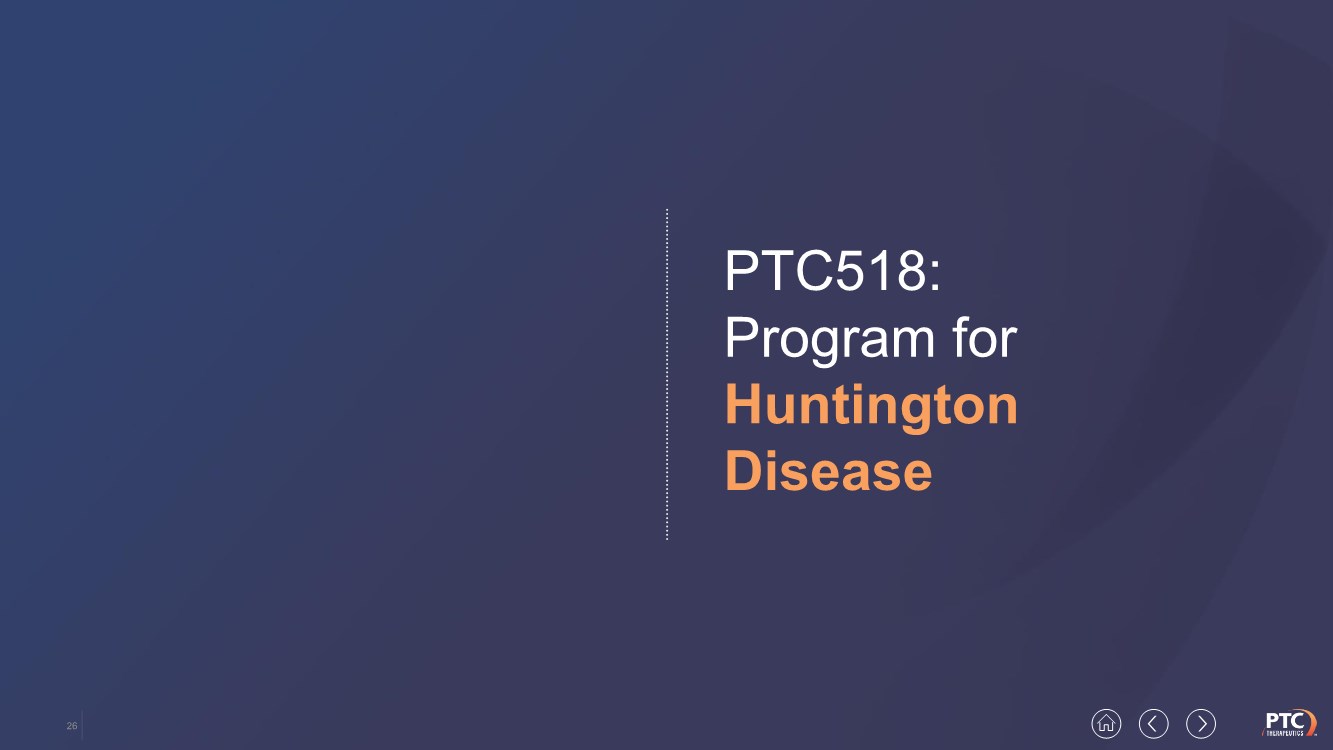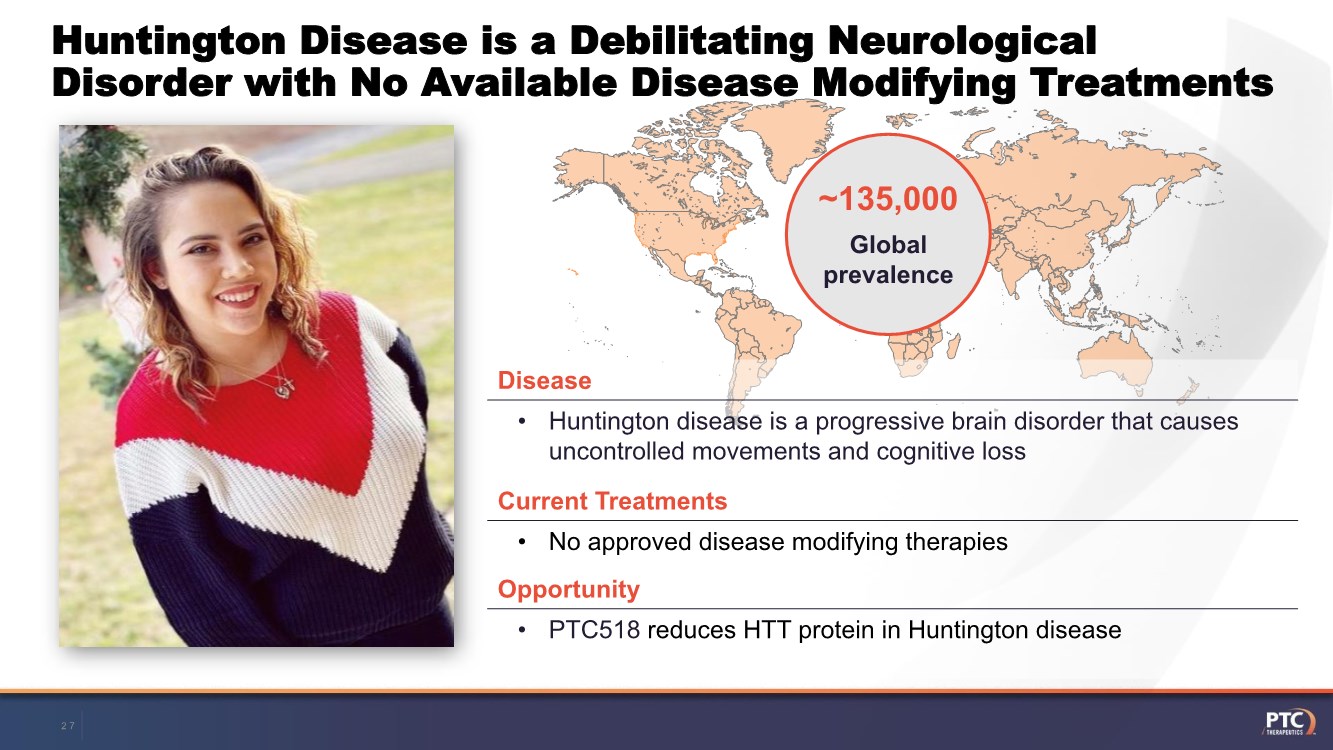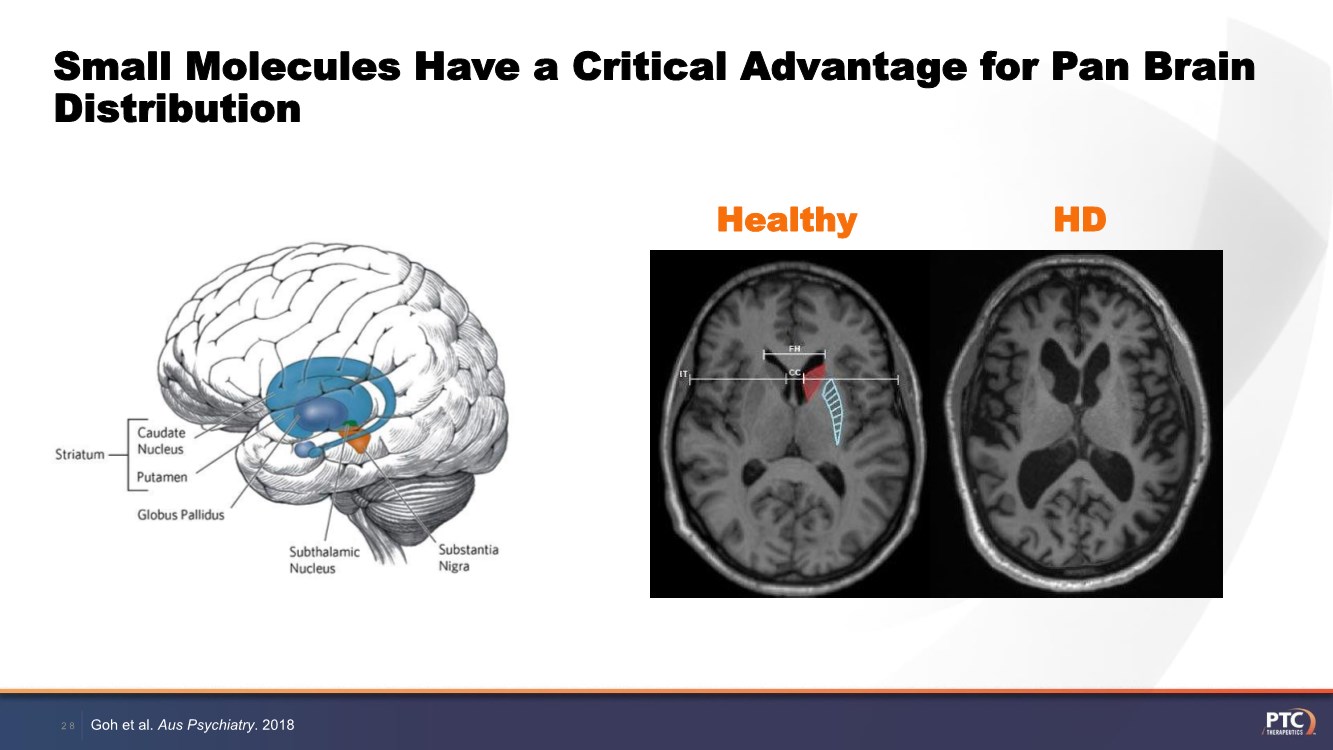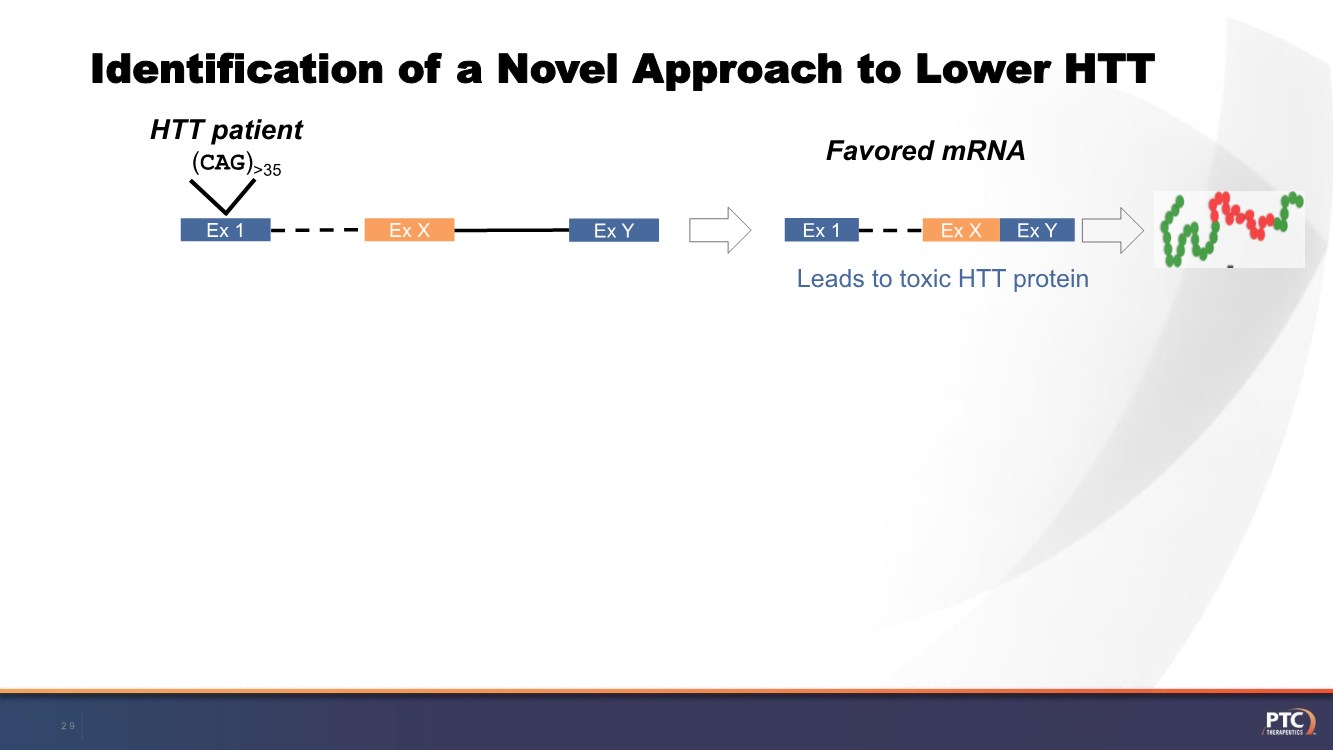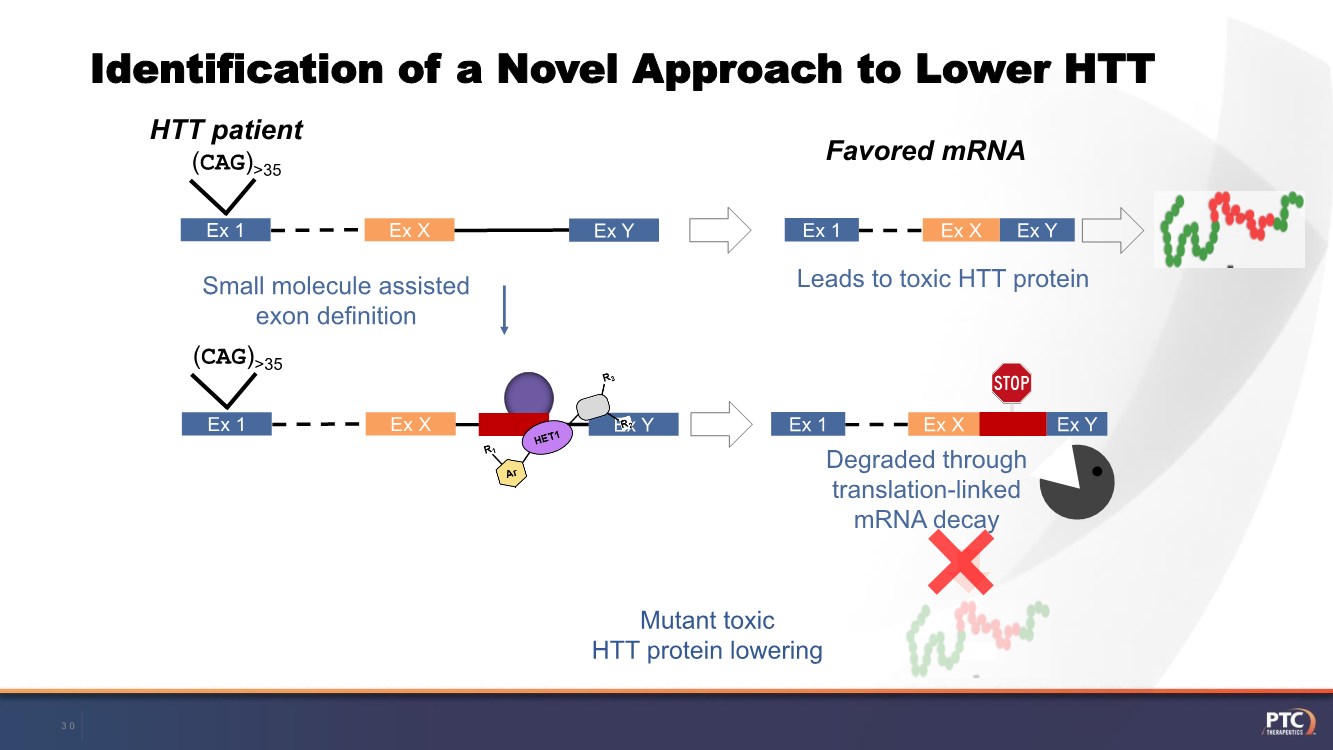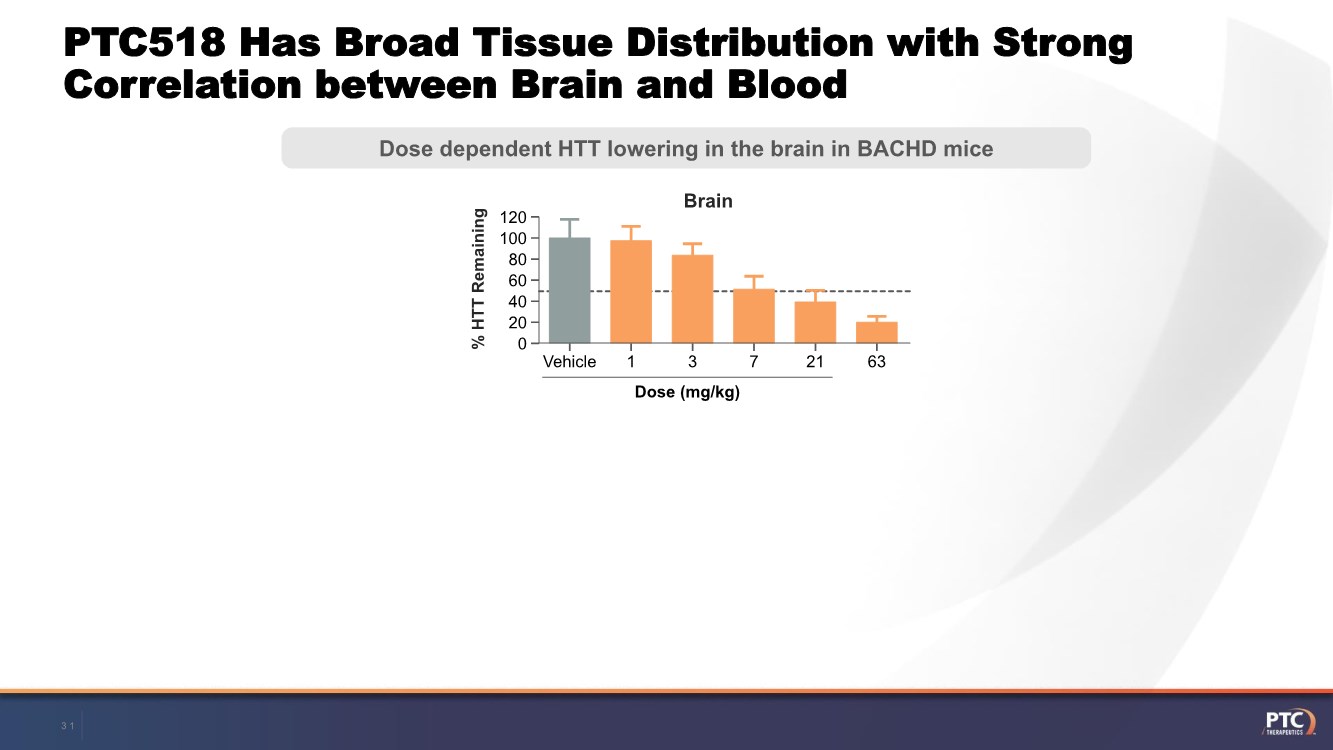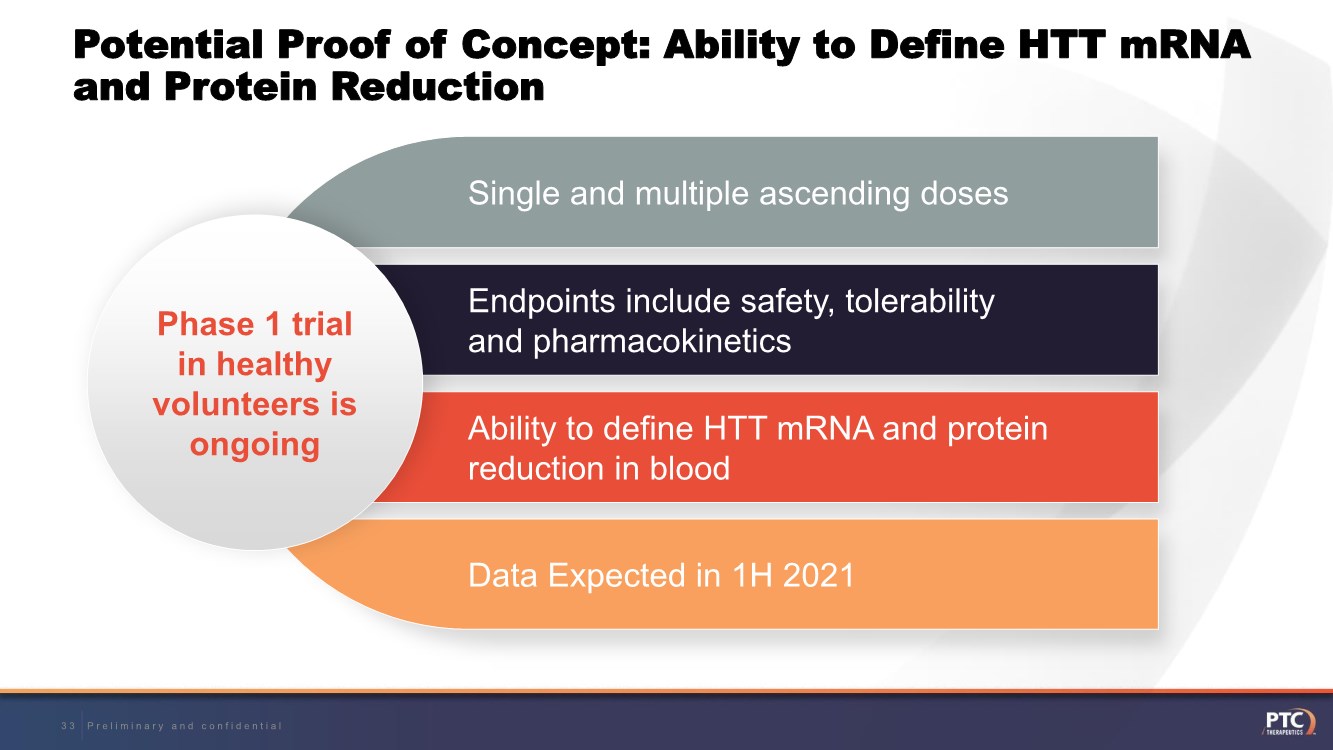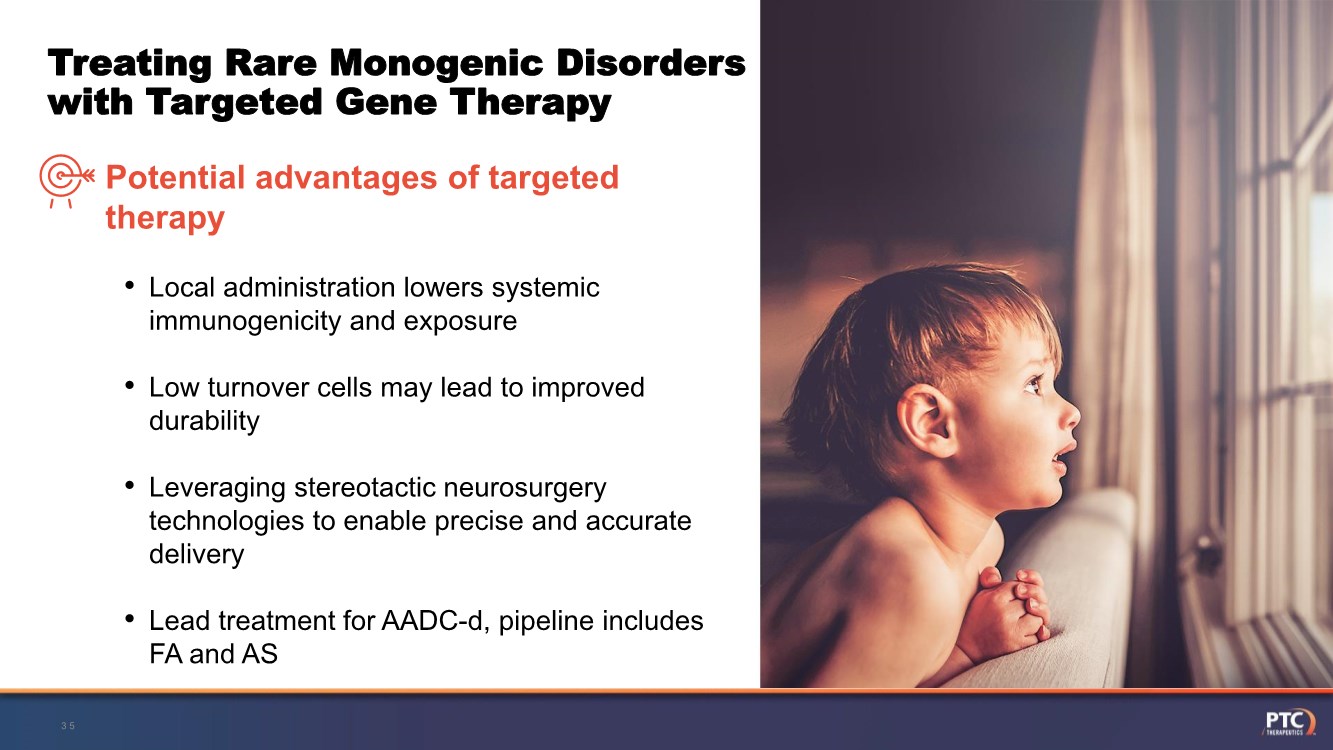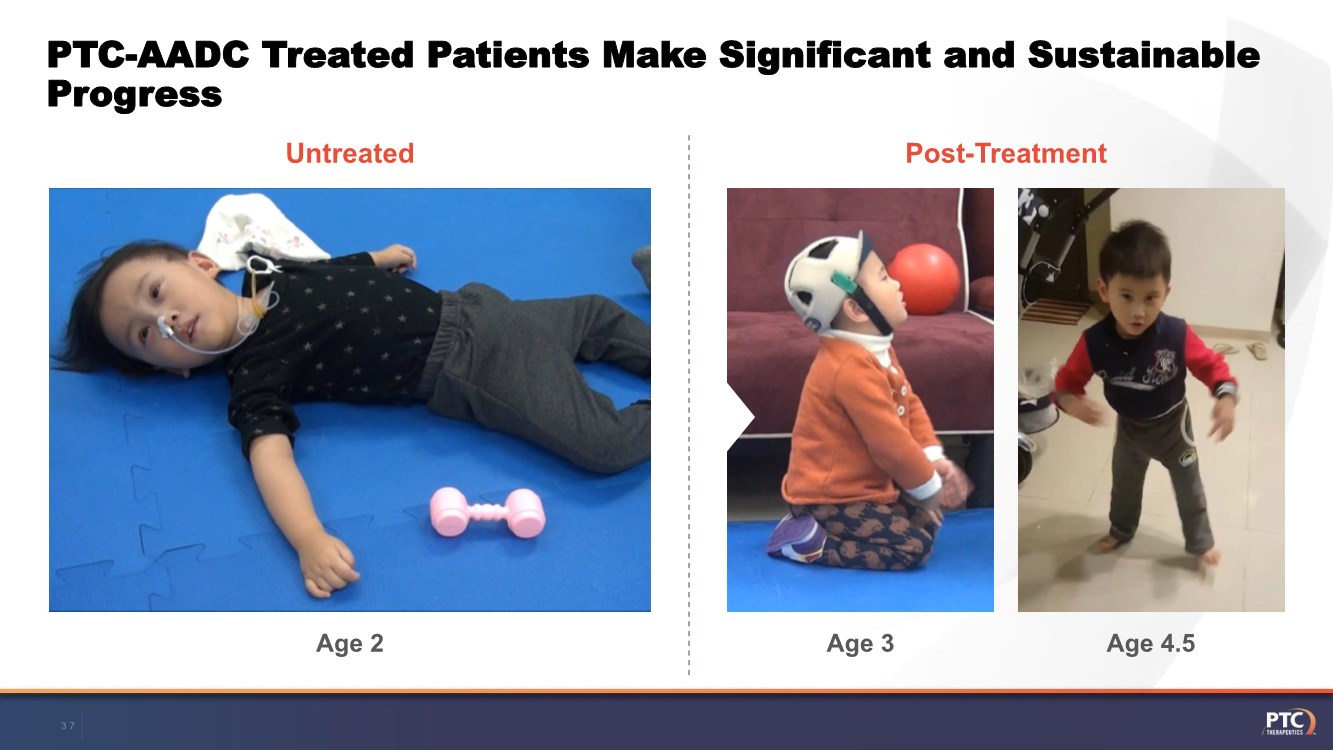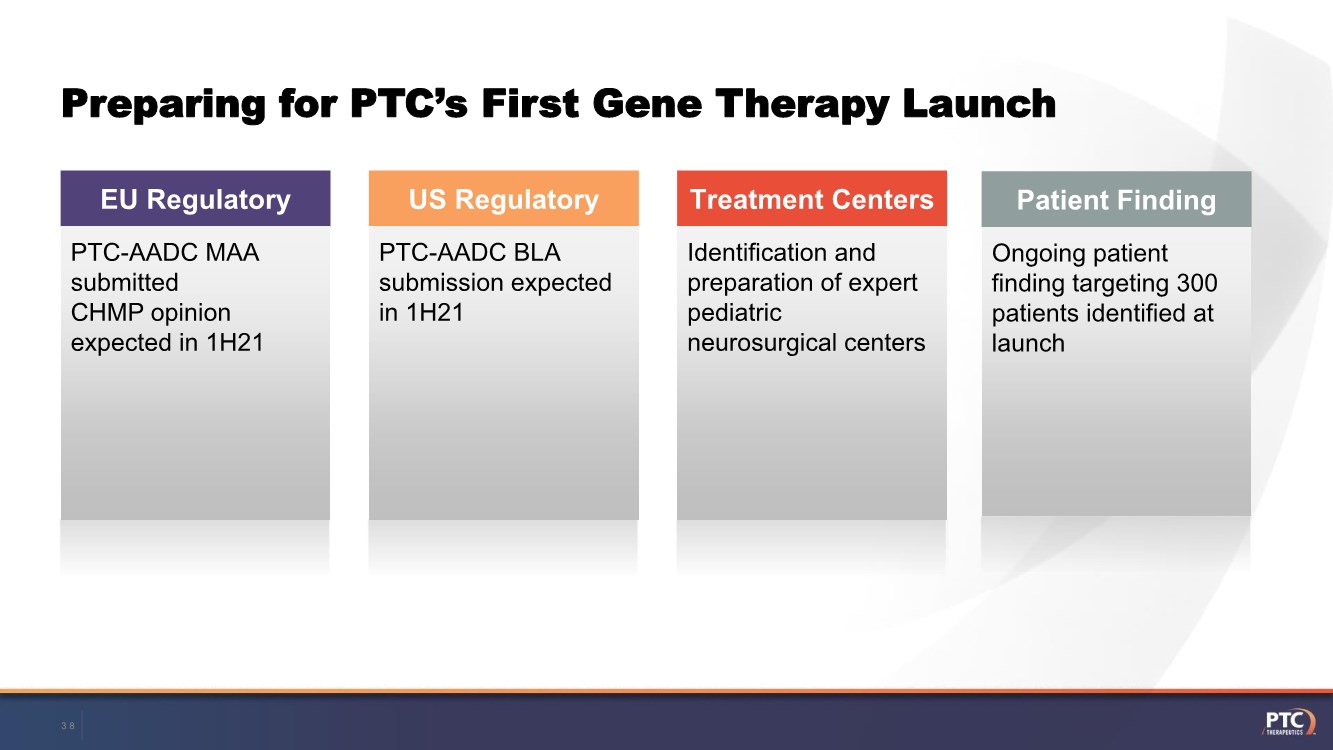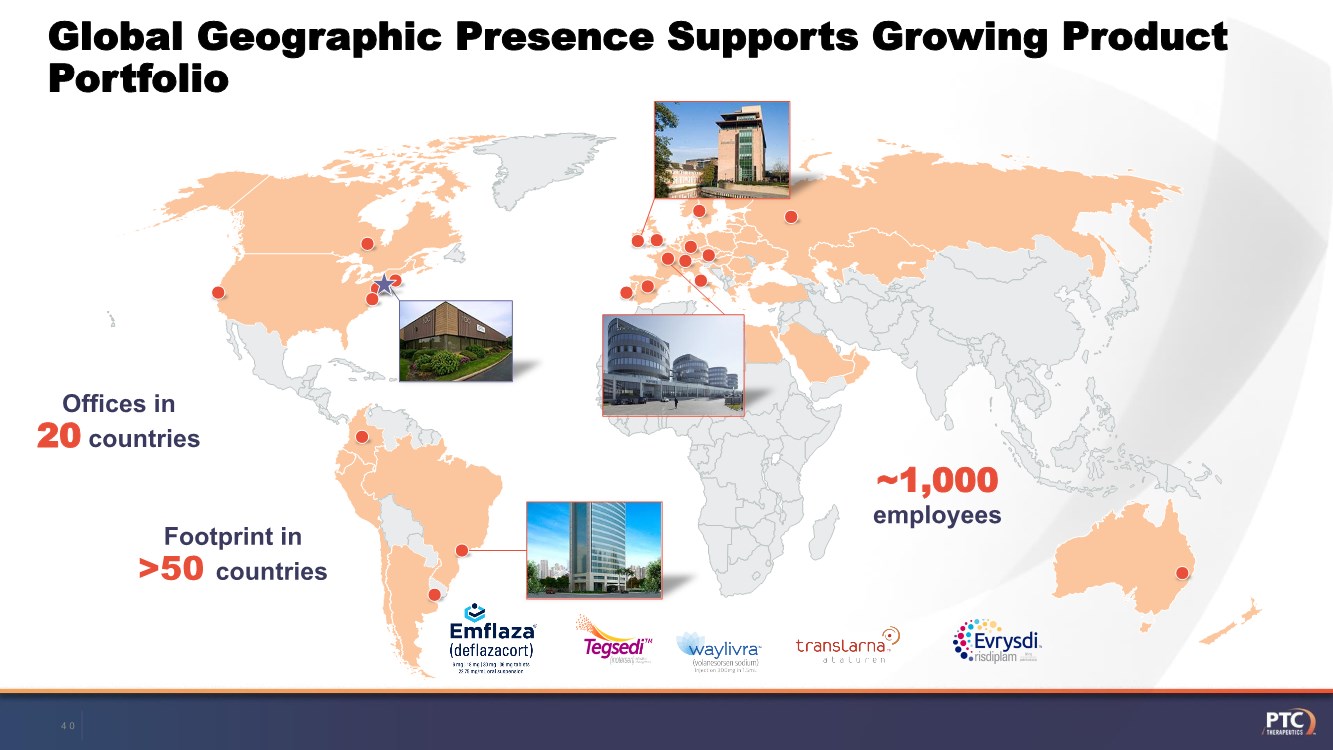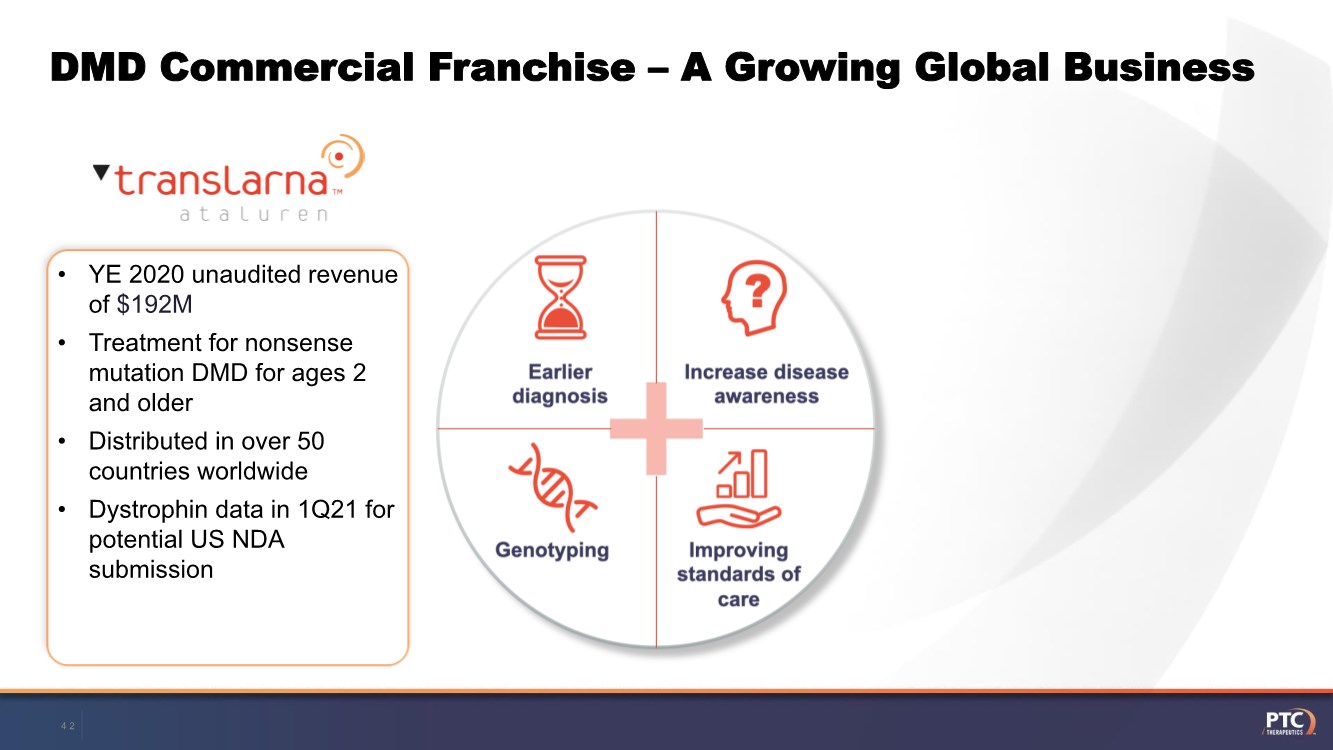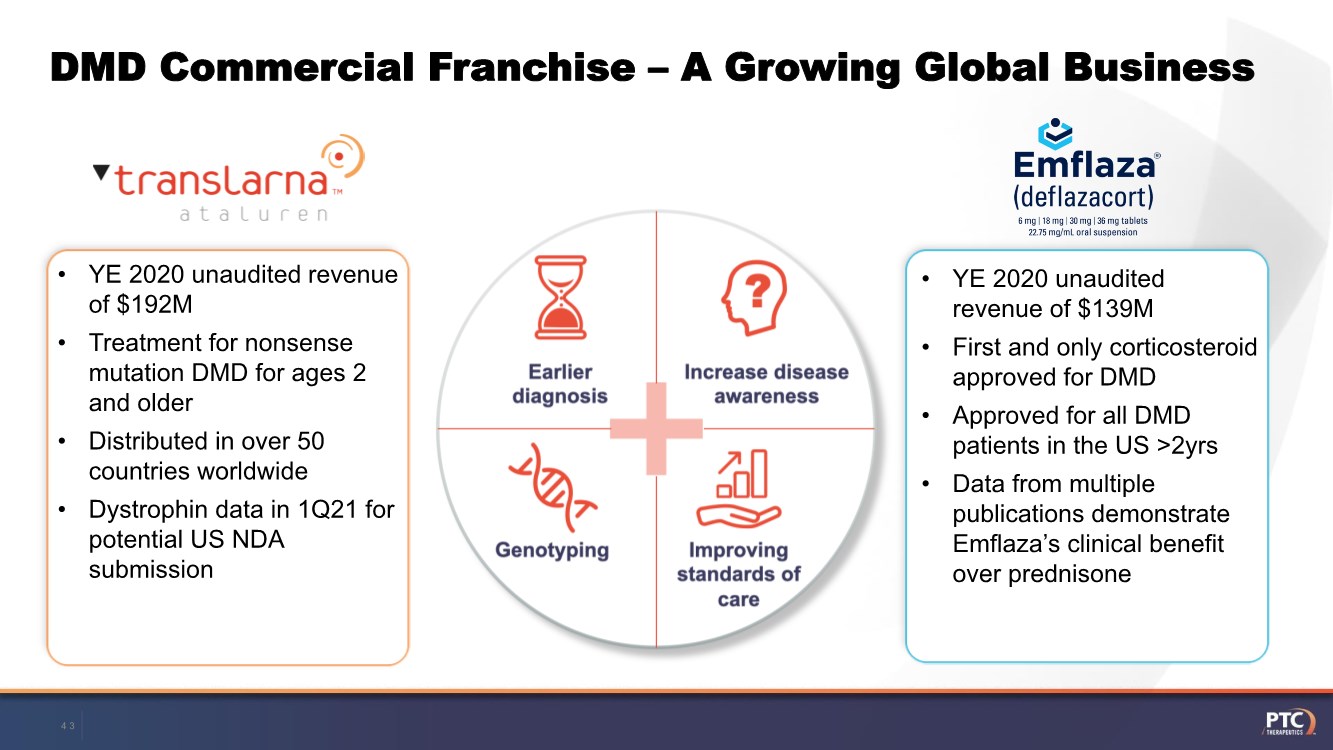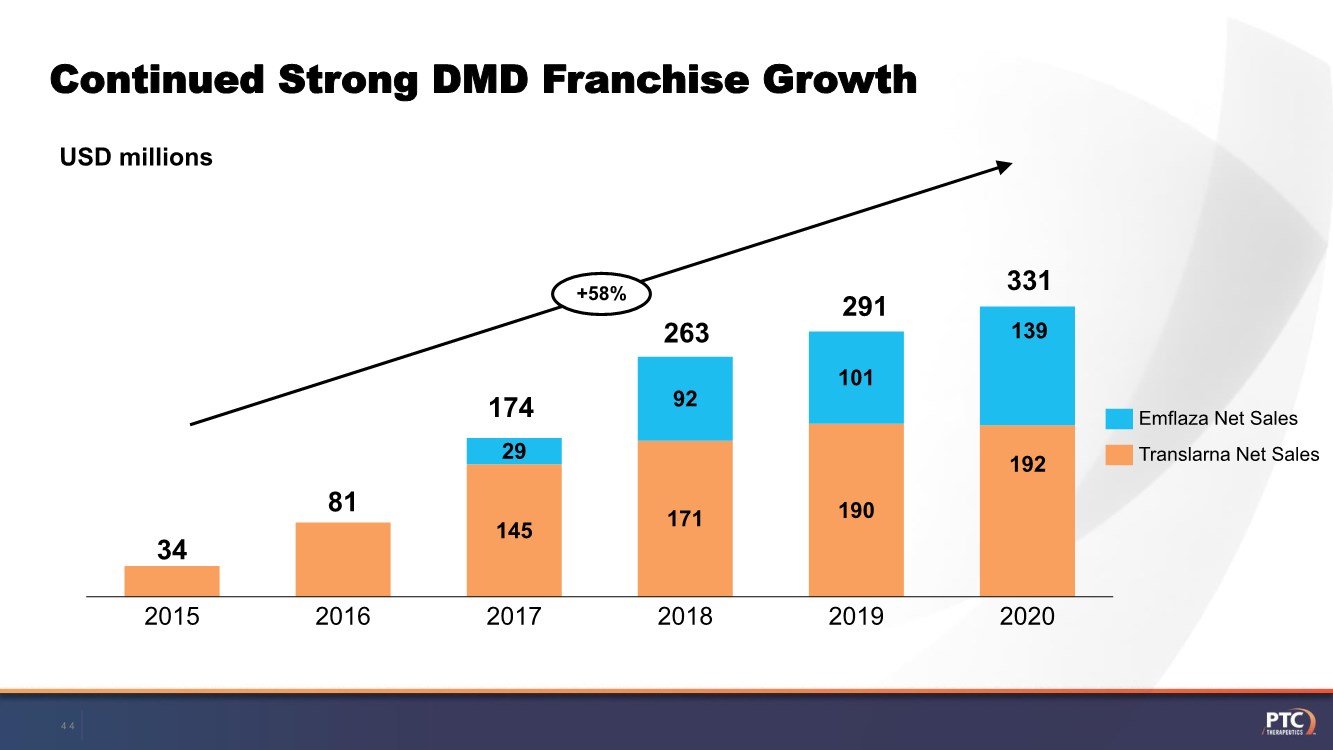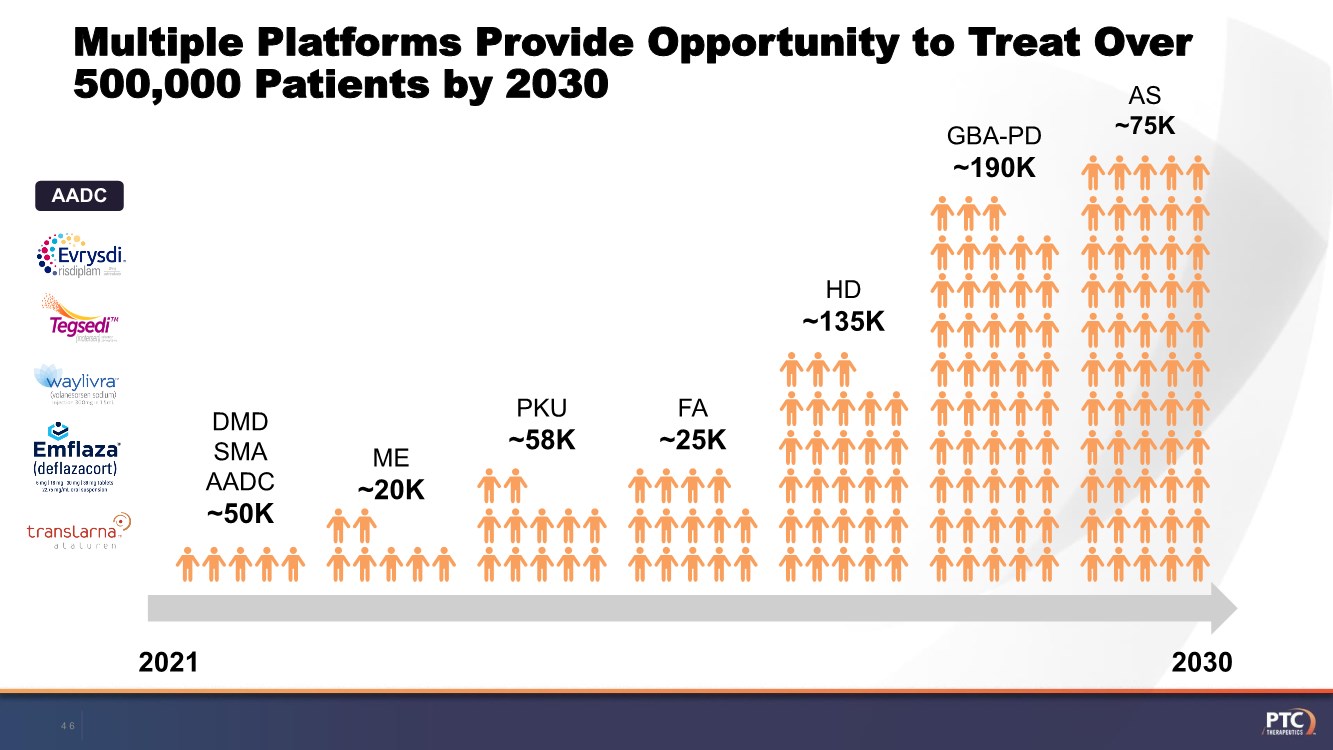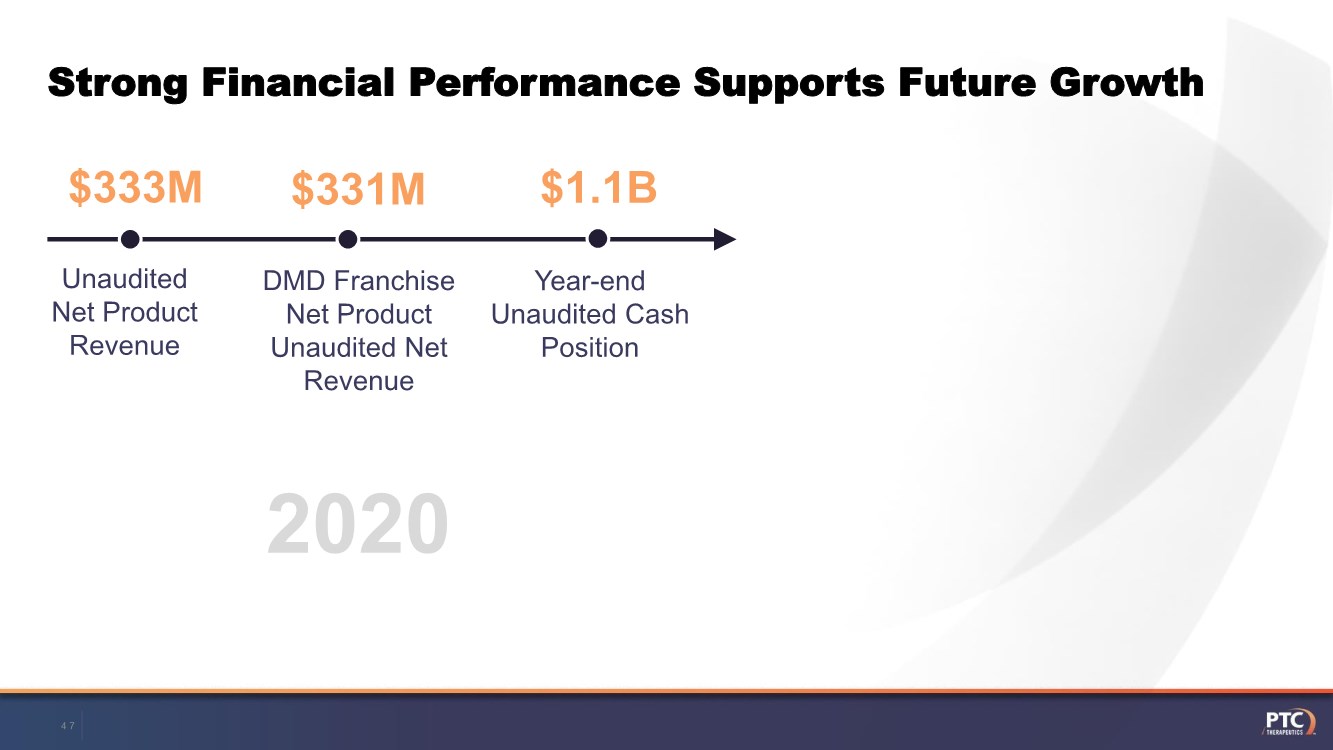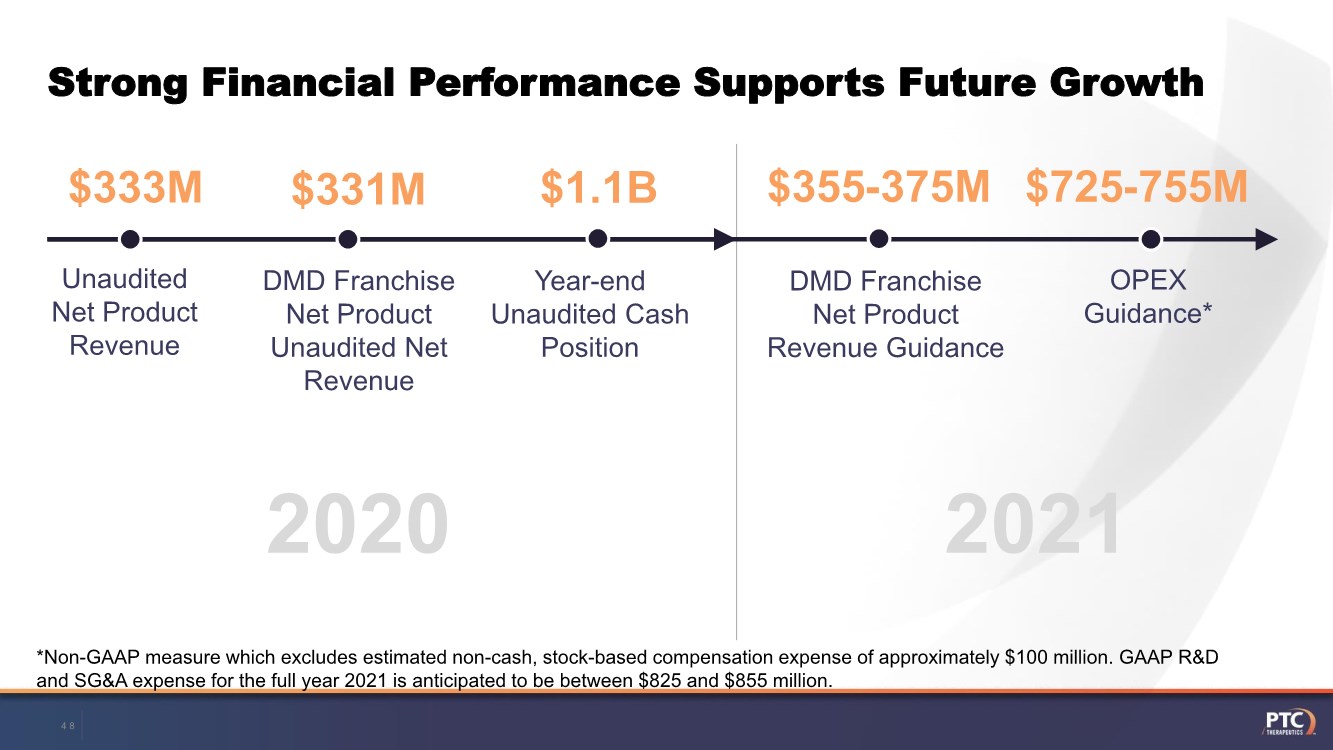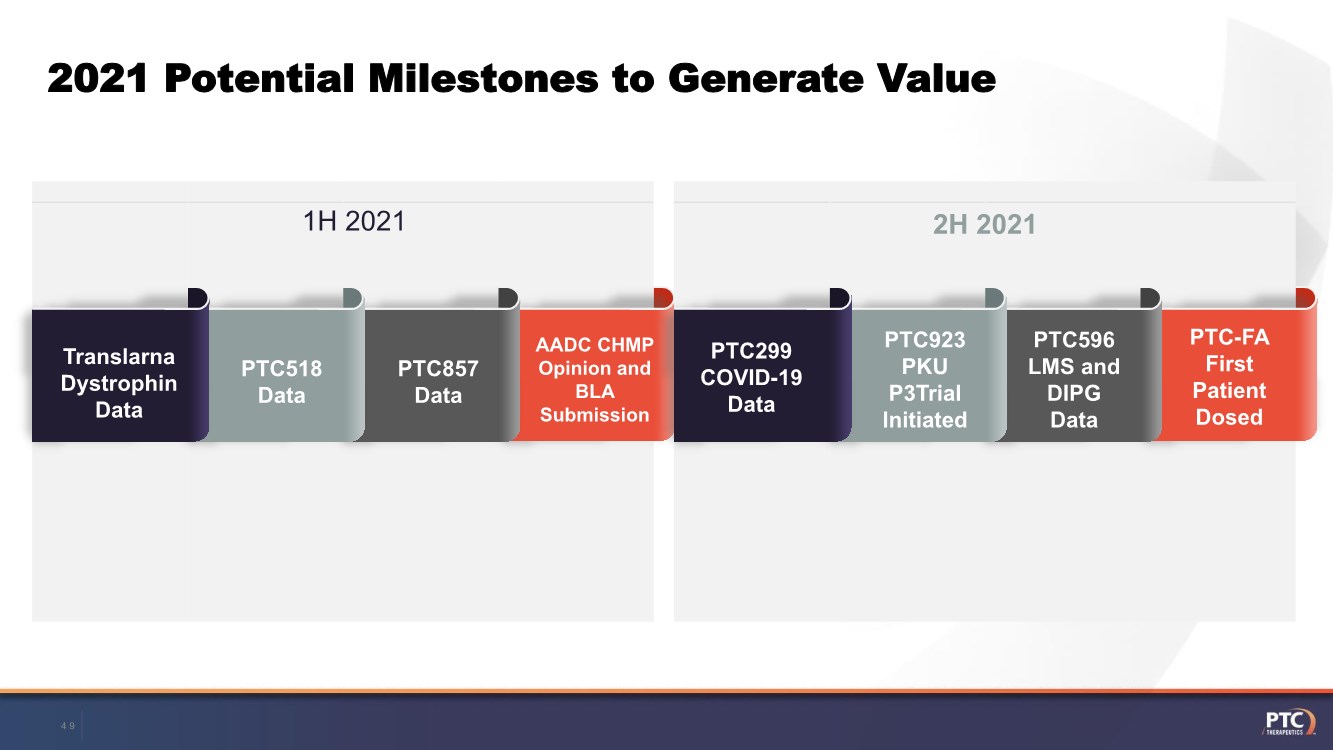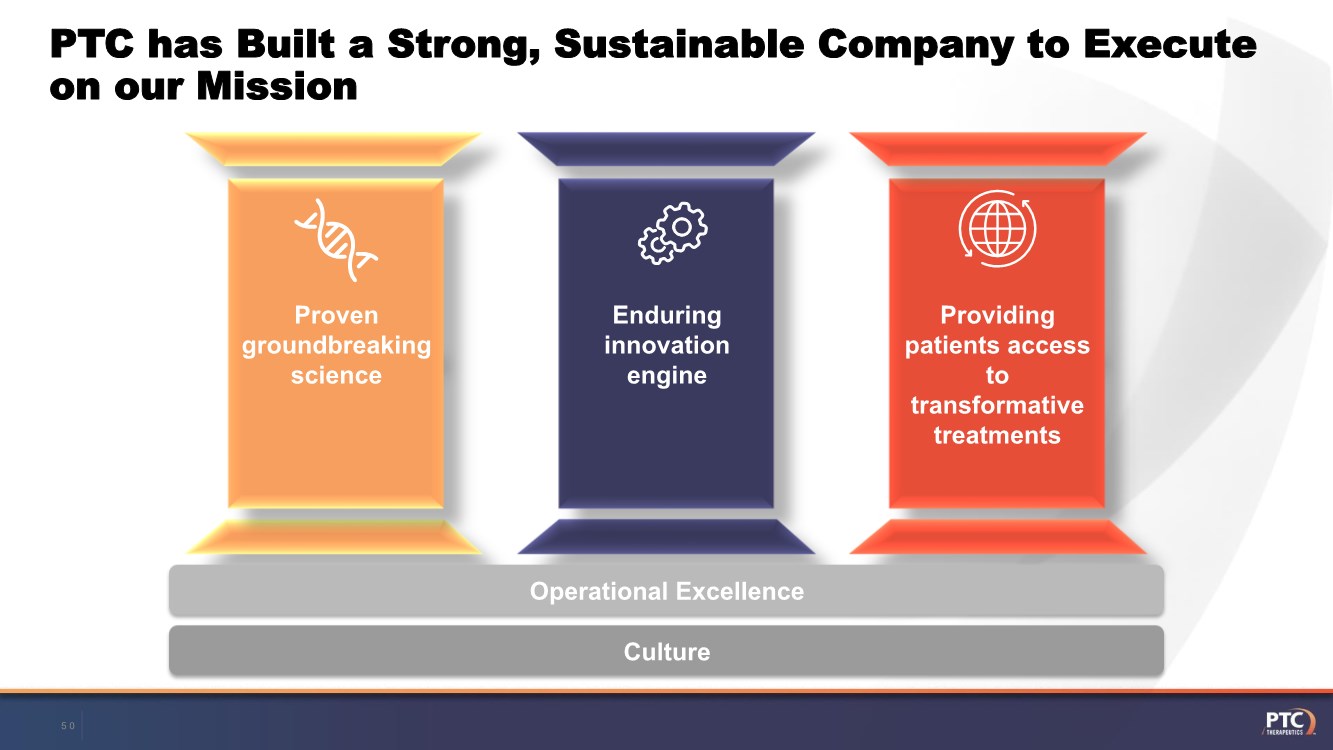Attached files
| file | filename |
|---|---|
| EX-99.1 - EX-99.1 - PTC THERAPEUTICS, INC. | tmb-20210111xex99d1.htm |
| 8-K - 8-K - PTC THERAPEUTICS, INC. | tmb-20210111x8k.htm |
Exhibit 99.2
| PTC 2021 J.P. Morgan Healthcare Conference Stuart W. Peltz, Ph.D., CEO |
| Forward Looking Statements This presentation contains forward-looking statements within the meaning of The Private Securities Litigation Reform Act of 199 5. All statements contained in this release, other than statements of historic fact, are forward -looking statements, including statements with respect to 2021 net product revenue guidance, statements with respect to the 2021 operating expenditure guidance and statements regarding: the future expectations, plans and prospects for PTC, including with respect to the expected timing of clinical trials and studies, availability of data, regulatory submissions and responses and other matters; expectations with respect to PTC's gene therapy platform, including any potential regulatory submissions and manufacturing capabilities; advancement of PTC's joint c ollaboration program in SMA, including any potential regulatory submissions, commercialization or royalty or milestone payments; PTC's expectations with respect to the licensing, regulatory submissions and commercialization of its products and product candidates; the timing with respect to orders for PTC's products; PTC's strategy, future operations, future financial position, future revenues, projected costs; and the objectives of management. Other forward -looking statements may be identified by the words "guidance", "plan," "anticipate," "believe," "estimate," "expect," "intend," "may," "target," "potential," "will," "would," "could," "should," "continue," and similar expressions. PTC's actual results, performance or achievements could differ materially from those expressed or implied by forward -looking statements it makes as a result of a variety of risks and uncertainties, including those related to: the outcome of pricing, coverage and reimbursement negotiations with third party payors for PTC's products or product candidates that PTC commercializes or may commercialize in the future; expectations with respect to PTC's gene therap y platform, including any potential regulatory submissions and potential approvals, manufacturing capabilities and the potential financial impact and benefits of its leased biologics manufacturing facility and the potential achievement of development, regulatory and sales milestones and contingent payments that PTC may be obligat ed to make; the enrollment, conduct, and results of ongoing studies under the SMA collaboration and events during, or as a result of, the studies that could delay or prevent further development under the program, including any potential regulatory submissions and potential commercialization with respect to Evrysdi; PTC's ability to complete a dystrophin study necessary to support a re-submission of its Translarna NDA for the treatment of nonsense mutation Duchenne muscular dystrophy (nmDMD) to t he FDA, and PTC's ability to perform any necessary additional clinical trials, non-clinical studies, and CMC assessments or analyses at significant cost; PTC's abili ty to maintain its marketing authorization of Translarna for the treatment of nmDMD in the European Economic Area (EEA), including whether the European Medicines Agency (E MA) determines in future annual renewal cycles that the benefit-risk balance of Translarna authorization supports renewal of such authorization; PTC's ability t o enroll, fund, complete and timely submit to the EMA the results of Study 041, a randomized, 18 -month, placebo-controlled clinical trial of Translarna for the treatment of nmDMD followed by an 18-month open- label extension, which is a specific obligation to continued marketing authorization in the EEA; expectations with respect to the commercialization of Tegsedi and Waylivra™; the enrollment, conduct and results of PTC's PTC299 clinical trial for COVID -19; expectations with respect to the COVID-19 pandemic and related response measures and their effects on PTC's business, operations, clinical trials, potential regulatory submissions and approvals, and PTC's collaborators, contract research organizations, suppliers and manufacturers; significant business effects, including the effects of industry , market, economic, political or regulatory conditions; changes in tax and other laws, regulations, rates and policies; the eligible patient base and commercial potentia l of PTC's products and product candidates; PTC's scientific approach and general development progress; PTC's ability to satisfy its obligations under the terms of the l ease agreement for its leased biologics manufacturing facility; the sufficiency of PTC's cash resources and its ability to obtain adequate financing in the future fo r its foreseeable and unforeseeable operating expenses and capital expenditures; and the factors discussed in the "Risk Factors" section of PTC's most recent Quarterly Rep ort on Form 10-Q and Annual Report on Form 10-K, as well as any updates to these risk factors filed from time to time in PTC's other filings with the SEC. You are urg ed to carefully consider all such factors. As with any pharmaceutical under development, there are significant risks in the development, regulatory approval and commerc ialization of new products. There are no guarantees that any product will receive or maintain regulatory approval in any territory, or prove to be commercially succes sful, including Translarna, Emflaza, Evrysdi, Tegsedi, Waylivra or PTC-AADC. The forward-looking statements contained herein represent PTC's views only as of the date of this presentation and PTC does not undertake or plan to update or revise any such forward-looking statements to reflect actual results or changes in plans, prospects, assumptions, estimates or projecti ons, or other circumstances occurring after the date of this presentation except as required by law. 2 |
| Translating Science to Transform Lives 3 |
| Significant Execution and Value Creation in 2020 4 Clinical Regulatory Commercial Financial ✓ Initiated two potential registrational trials with vatiquinone in Mitochondrial Epilepsy & Friedreich ataxia ✓ Completed Translarna™ dystrophin trial for potential US accelerated approval ✓ Initiated trial of PTC518 in healthy volunteers for Huntington disease program ✓ Evrysdi™ approval in US and multiple additional countries ✓ Submitted MAA to EMA for gene therapy to treat AADC deficiency ✓ Translarna label modification related to non-ambulatory patients ✓ Broader patient access and continued geographic growth of Translarna ✓ Strong Emflaza growth; 38% YoY ✓ Evrysdi strong commercial launch ✓ Strengthened balance sheet; over $1B cash position ✓ 2020 unaudited: $333M Net Product Revenue; $331M DMD Franchise Net Product Revenue; $42.5M Roche Collaboration Revenue associated with Evrysdi regulatory and sales milestones |
| Diversified Platform Drives Strong Portfolio 5 Clinical Commercial Research Nonsense Mutation LatAm Commercial Deflazacort Gene Therapy Bio-e Metabolic Oncology US Dystrophin PTC-AADC PTC299 AML PTC596 DIPG PTC596 LMS Vatiquinone ME Vatiquinone FA PTC923 PKU PTC299 COVID-19 SCA-3 Undisclosed MAP-Tau PTC857 GBA-PD PTC518 HD Splicing Virology • AADC, aromatic L-amino acid decarboxylase deficiency; AML; acute myeloid leukemia; COVID-19, coronavirus disease 2019; DIPG, diffuse intrinsic pontine glioma; FA, Friedreich’s ataxia; GBA, glucocerebrosidase; HD, Huntington‘s disease; IRD, inherited retinal dystrophy; LMS, leiomyosarcoma; ME, Mitochondrial Epilepsy; PD, Parkinson’s disease; PKU, phenylketonuria; SCA-3, spinocerebellar ataxia type 3. SCIENTIFIC PLATFORMS and RESEARCH Potential registrational studies Angelman IRDs Cog Disorders FA |
| Enduring Innovation Engine 6 |
| Diversified Platform Drives Strong Portfolio 7 Clinical Commercial Research Nonsense Mutation LatAm Commercial Deflazacort Gene Therapy Bio-e Metabolic Oncology US Dystrophin PTC-AADC PTC299 AML PTC596 DIPG PTC596 LMS Vatiquinone ME Vatiquinone FA PTC923 PKU PTC299 COVID-19 SCA-3 Undisclosed MAP-Tau PTC857 GBA-PD PTC518 HD Splicing Virology • AADC-d, aromatic L-amino acid decarboxylase deficiency; AML; acute myeloid leukemia; COVID-19, coronavirus disease 2019; DIPG, diffuse intrinsic pontine glioma; FA, Friedreich’s ataxia; GBA, glucocerebrosidase; HD, Huntington‘s disease; IRD, inherited retinal dystrophy; LMS, leiomyosarcoma; ME, Mitochondrial Epilepsy; PD, Parkinson’s disease; PKU, phenylketonuria; SCA-3, spinocerebellar ataxia type 3. SCIENTIFIC PLATFORMS and RESEARCH Potential registrational studies Angelman IRDs Cog Disorders FA |
| O OH O OH Oxidized Fatty Acids Enzyme Polyunsaturated Fatty Acids O OH Bio-e Platform is a Novel Approach to Treating Rare Disorders Polyunsaturated Fatty Acids Oxidized Fatty Acids Activated Enzyme Oxidative stress cellular viability & neurological function inflammation & oxidative stress decreased increased 8 • Bio-e platform targets a family of oxidoreductase enzymes critical to generation and regulation of energy key to disease pathology • Dysregulation of this pathway results in several CNS disease pathologies including epilepsy • 15-lipoxygenase is a well- known regulator key to CNS and other diseases |
| Enzyme Polyunsaturated Fatty Acids O OH Bio-e Platform is a Novel Approach to Treating Rare Disorders Polyunsaturated Fatty Acids Oxidized Fatty Acids Activated Enzyme Oxidative stress Inhibited 9 PTC Compounds O O HO • Bio-e platform targets a family of oxidoreductase enzymes critical to generation and regulation of energy key to disease pathology • Dysregulation of this pathway results in several CNS disease pathologies including epilepsy • 15-lipoxygenase is a well- known regulator key to CNS and other diseases cellular viability & neurological function inflammation & oxidative stress increased decreased |
| 10 MIT-E: Registrational trial of vatiquinone for Mitochondrial Epilepsy |
| Mitochondrial Epilepsy is a Highly Morbid Disorder with High Unmet Medical Need Disease • Mitochondrial epilepsy is the highly morbid condition of refractory seizures in patients with inherited mitochondrial disease Current Treatments • No approved disease modifying treatments for mitochondrial epilepsy Opportunity • Vatiquinone targets the energetic and oxidative stress pathways that underpin seizures in these patients ~20,000 Global Prevalence 11 |
| Vatiquinone Reduced Seizure Frequency and Improved Neurological Function in Mitochondrial Epilepsy Patients 12 Disruption of refractory status epilepticus Reduction in seizure frequency Decrease in seizure-related hospitalizations Decrease in disease-related mortality risk Data from previous studies demonstrate a positive effect on seizures and seizure related- morbidity across multiple disease subtypes |
| Vatiquinone has Potential to Show Clinically Differentiated Improvement for Mitochondrial Epilepsy Patients 13 Primary Endpoint Change from baseline in frequency of observable motor seizures PTC743 (vatiquinone) Placebo N = 30 (planned) 24 weeks R N = 30 (planned) 48 weeks PTC743 (vatiquinone) N = 60 (planned) Open-Label Extension Placebo-Controlled ~15 sites globally Primary Endpoint Trial Status • Enrolling • Data expected 3Q 2022 |
| 14 MOVE-FA: Registrational trial of vatiquinone for Friedreich Ataxia |
| Friedreich Ataxia is a Highly Morbid, Neuromuscular Disorder with no Approved Therapy Disease • Friedreich ataxia (FA) is a rare, inherited, progressive disease resulting from mitochondrial dysfunction that mainly affects the central nervous system and the heart Current Treatments • No approved disease modifying therapies Opportunity • Vatiquinone is a potent protector of oxidative stress-mediated cell death in FA patients ~25,000 Global prevalence 15 |
| Vatiquinone Demonstrated Significant Improvement in Long-term Disease Severity & Neurological Function in Friedreich Ataxia Patients Clinical Study Summary • Double-blind, placebo-controlled with delayed start • N=63 subjects • Three US clinical sites • Key endpoint: FA disease rating scale (FARS) 16 -1 -2 -3 2 1 0 4 3 5 6 Natural History Cohort Vatiquinone p<0.001 24 - month change in FARS score 16 |
| Vatiquinone has the Potential to Provide Improvement in Neurological Function 17 Primary and Key Secondary Endpoints Change from baseline in the Modified FA Rating Scale (mFARS) Score at Week 72 Improvement in activities of daily living (FA-ADL) Open-Label Extension Placebo-Controlled PTC743 (vatiquinone) Placebo N = ~60 72 weeks R N = ~60 24 weeks PTC743 (vatiquinone) N = ~120 Primary Endpoint ~10 sites globally Trial Status • Enrolling • Data expected in 2023 |
| Diversified Platform Drives Strong Portfolio 18 Clinical Commercial Research Nonsense Mutation LatAm Commercial Deflazacort Gene Therapy Bio-e Metabolic Oncology US Dystrophin PTC-AADC PTC299 AML PTC596 DIPG PTC596 LMS Vatiquinone ME Vatiquinone FA PTC923 PKU PTC299 COVID-19 SCA-3 Undisclosed MAP-Tau PTC857 GBA-PD PTC518 HD Splicing Virology • AADC, aromatic L-amino acid decarboxylase deficiency; AML; acute myeloid leukemia; COVID-19, coronavirus disease 2019; DIPG, diffuse intrinsic pontine glioma; FA, Friedreich’s ataxia; GBA, glucocerebrosidase; HD, Huntington‘s disease; IRD, inherited retinal dystrophy; LMS, leiomyosarcoma; ME, Mitochondrial Epilepsy; PD, Parkinson’s disease; PKU, phenylketonuria; SCA-3, spinocerebellar ataxia type 3. SCIENTIFIC PLATFORMS and RESEARCH Potential registrational studies Angelman IRDs Cog Disorders FA |
| 19 APHENITY: Registrational trial of PTC923 for Phenylketonuria (PKU) |
| Phenylketonuria is a Serious Metabolic Condition with High Unmet Medical Need ~58,000 Global prevalence Disease • Phenylketonuria is a metabolic condition caused by mutations to phenylalanine hydroxylase that can lead to cognitive disabilities and seizures Current Treatments • Majority of patients do not initially respond or are not well controlled by standard of care Opportunity • PTC923 can potentially treat a broad population and is more effective than exogenously administered synthetic BH4 in increasing the intracellular levels of natural tetrahydrobiopterin 20 |
| Majority of PKU Patients not Addressed by Current Therapies 21 ~ 25-30% of diagnosed patients ~60-75% of diagnosed patients |
| Majority of PKU Patients not Addressed by Current Therapies 22 ~ 25-30% of diagnosed patients ~60-75% of diagnosed patients Up to 70% of Kuvan Failure Up to 60% of Initial Responders Are Poorly controlled on Kuvan Up to 30% of diagnosed patients |
| PTC923 Demonstrated Statistically Significant Differences in Reduction of Phenylalanine (Phe) Compared to Kuvan in Phase 2 Study 23 p< 0.0001 |
| APHENITY is a Global Registrational Trial of PTC923 for Phenylketonuria 24 R PTC923 Placebo Primary Endpoint Reduction in blood of phenylalanine hydroxylase levels 42 Days ~12 sites in 15-19 countries Open-Label Extension Placebo-Controlled PTC923 12 Months Primary Endpoint Trial Status • Initiating in mid-2021 • Data expected YE 2022 |
| Diversified Platform Drives Strong Portfolio 25 Clinical Commercial Research Nonsense Mutation LatAm Commercial Deflazacort Gene Therapy Bio-e Metabolic Oncology US Dystrophin PTC-AADC PTC299 AML PTC596 DIPG PTC596 LMS Vatiquinone ME Vatiquinone FA PTC923 PKU PTC299 COVID-19 SCA-3 Undisclosed MAP-Tau PTC857 GBA-PD PTC518 HD Splicing Virology • AADC, aromatic L-amino acid decarboxylase deficiency; AML; acute myeloid leukemia; COVID-19, coronavirus disease 2019; DIPG, diffuse intrinsic pontine glioma; FA, Friedreich’s ataxia; GBA, glucocerebrosidase; HD, Huntington‘s disease; IRD, inherited retinal dystrophy; LMS, leiomyosarcoma; ME, Mitochondrial Epilepsy; PD, Parkinson’s disease; PKU, phenylketonuria; SCA-3, spinocerebellar ataxia type 3. SCIENTIFIC PLATFORMS and RESEARCH Potential registrational studies Angelman IRDs Cog Disorders FA |
| 26 PTC518: Program for Huntington Disease |
| Huntington Disease is a Debilitating Neurological Disorder with No Available Disease Modifying Treatments Disease • Huntington disease is a progressive brain disorder that causes uncontrolled movements and cognitive loss Current Treatments • No approved disease modifying therapies Opportunity • PTC518 reduces HTT protein in Huntington disease ~135,000 Global prevalence 27 |
| Small Molecules Have a Critical Advantage for Pan Brain Distribution 28 HD Healthy Goh et al. Aus Psychiatry. 2018 |
| Identification of a Novel Approach to Lower HTT 29 HTT patient Ex 1 Ex Y Ex X Favored mRNA Ex 1 Ex Y Ex X Leads to toxic HTT protein (CAG)>35 |
| Identification of a Novel Approach to Lower HTT 30 HTT patient Ex 1 Ex Y Ex X Favored mRNA Ex 1 Ex Y Ex X Leads to toxic HTT protein (CAG)>35 Degraded through translation-linked mRNA decay Ex 1 Ex Y Ex X Mutant toxic HTT protein lowering Ex 1 Ex Y Ex X (CAG)>35 Small molecule assisted exon definition |
| PTC518 Has Broad Tissue Distribution with Strong Correlation between Brain and Blood 31 120 100 80 60 40 20 0 Vehicle 1 3 7 21 63 Brain % HTT Remaining Dose dependent HTT lowering in the brain in BACHD mice Dose (mg/kg) |
| PTC518 Has Broad Tissue Distribution with Strong Correlation between Brain and Blood 32 120 100 80 60 40 20 0 Vehicle 1 3 7 21 63 Brain % HTT Remaining Dose dependent HTT lowering in the brain in BACHD mice Brain and blood HTT lowering Dose (mg/kg) *Data on file from multiple studies Measurements demonstrate uniform HTT lowering across brain regions with ~1:1 brain and blood concentrations* 120 100 80 60 40 20 0 Vehicle 7 mg/kg 120 100 80 60 40 20 0 Vehicle 7 mg/kg 120 100 80 60 40 20 0 Vehicle 7 mg/kg Striatum Cortex Cerebellum % HTT Remaining % HTT Remaining % HTT Remaining Vehicle Brain WBC 0 20 40 60 80 100 120 % H T T R e m a i n i n g Treated |
| Potential Proof of Concept: Ability to Define HTT mRNA and Protein Reduction Preliminary and confidential 33 Phase 1 trial in healthy volunteers is ongoing Single and multiple ascending doses Endpoints include safety, tolerability and pharmacokinetics Ability to define HTT mRNA and protein reduction in blood Data Expected in 1H 2021 |
| Diversified Platform Drives Strong Portfolio 34 Clinical Commercial Research Nonsense Mutation LatAm Commercial Deflazacort Gene Therapy Bio-e Metabolic Oncology US Dystrophin PTC-AADC PTC299 AML PTC596 DIPG PTC596 LMS Vatiquinone ME Vatiquinone FA PTC923 PKU PTC299 COVID-19 SCA-3 Undisclosed MAP-Tau PTC857 GBA-PD PTC518 HD Splicing Virology • AADC, aromatic L-amino acid decarboxylase deficiency; AML; acute myeloid leukemia; COVID-19, coronavirus disease 2019; DIPG, diffuse intrinsic pontine glioma; FA, Friedreich’s ataxia; GBA, glucocerebrosidase; HD, Huntington‘s disease; IRD, inherited retinal dystrophy; LMS, leiomyosarcoma; ME, Mitochondrial Epilepsy; PD, Parkinson’s disease; PKU, phenylketonuria; SCA-3, spinocerebellar ataxia type 3. SCIENTIFIC PLATFORMS and RESEARCH Potential registrational studies Angelman IRDs Cog Disorders FA |
| Treating Rare Monogenic Disorders with Targeted Gene Therapy 35 Potential advantages of targeted therapy • Local administration lowers systemic immunogenicity and exposure • Low turnover cells may lead to improved durability • Leveraging stereotactic neurosurgery technologies to enable precise and accurate delivery • Lead treatment for AADC-d, pipeline includes FA and AS |
| Gene Therapy Has the Potential to Provide Significant Benefit to AADC Patients Disease • Aromatic L-amino acid decarboxylase deficiency (AADC-d) is a rare highly morbid and fatal childhood disease. Children with severe AADC deficiency never achieve motor development milestones Current Treatments • No disease modifying therapies approved Opportunity • Potential for AADC gene therapy to become standard of care. Patients can achieve motor and cognitive long-term improvement ~5,000 Global prevalence 36 |
| PTC-AADC Treated Patients Make Significant and Sustainable Progress 37 Age 2 Age 3 Age 4.5 Untreated Post-Treatment |
| Preparing for PTC’s First Gene Therapy Launch 38 US Regulatory PTC-AADC BLA submission expected in 1H21 Treatment Centers Identification and preparation of expert pediatric neurosurgical centers EU Regulatory PTC-AADC MAA submitted CHMP opinion expected in 1H21 Patient Finding Ongoing patient finding targeting 300 patients identified at launch |
| Providing Patients Access to Transformative Treatments 39 |
| Global Geographic Presence Supports Growing Product Portfolio 40 ~1,000 employees Offices in 20 countries Footprint in >50 countries |
| DMD Commercial Franchise – A Growing Global Business 41 |
| DMD Commercial Franchise – A Growing Global Business 42 • YE 2020 unaudited revenue of $192M • Treatment for nonsense mutation DMD for ages 2 and older • Distributed in over 50 countries worldwide • Dystrophin data in 1Q21 for potential US NDA submission |
| DMD Commercial Franchise – A Growing Global Business 43 • YE 2020 unaudited revenue of $192M • Treatment for nonsense mutation DMD for ages 2 and older • Distributed in over 50 countries worldwide • Dystrophin data in 1Q21 for potential US NDA submission • YE 2020 unaudited revenue of $139M • First and only corticosteroid approved for DMD • Approved for all DMD patients in the US >2yrs • Data from multiple publications demonstrate Emflaza’s clinical benefit over prednisone |
| Continued Strong DMD Franchise Growth USD millions 34 81 145 171 190 29 92 101 2019 2020 2017 2015 2016 2018 263 174 331 +58% 291 Emflaza Net Sales Translarna Net Sales 139 192 44 |
| Evrysdi’s Strong Global Launch Brings Therapy to SMA Patients with High Unmet Need 45 Patients treated across all SMA types Patients are treatment-naïve or switching from both Spinraza and Zolgensma Broadest range of age treated Differentiated product for SMA patients • The first at-home, oral treatment for SMA • Global approvals and regulatory submissions • CHMP opinion expected in 1H 2021 • Under priority review in Japan Significant milestones ahead • Potential $355 million in sales and regulatory milestones • ~15% tiered royalty on global sales |
| Multiple Platforms Provide Opportunity to Treat Over 500,000 Patients by 2030 46 DMD SMA AADC ~50K ME ~20K PKU ~58K FA ~25K HD ~135K GBA-PD ~190K AS ~75K 2021 2030 AADC |
| Strong Financial Performance Supports Future Growth 47 Unaudited Net Product Revenue $333M DMD Franchise Net Product Unaudited Net Revenue $331M $1.1B Year-end Unaudited Cash Position 2020 |
| Strong Financial Performance Supports Future Growth 48 DMD Franchise Net Product Revenue Guidance $355-375M OPEX Guidance* $725-755M Unaudited Net Product Revenue $333M DMD Franchise Net Product Unaudited Net Revenue $331M 2020 2021 $1.1B Year-end Unaudited Cash Position *Non-GAAP measure which excludes estimated non-cash, stock-based compensation expense of approximately $100 million. GAAP R&D and SG&A expense for the full year 2021 is anticipated to be between $825 and $855 million. |
| 2021 Potential Milestones to Generate Value 49 AADC CHMP Opinion and BLA Submission PTC857 Data PTC518 Data Translarna Dystrophin Data PTC-FA First Patient Dosed PTC596 LMS and DIPG Data PTC923 PKU P3Trial Initiated PTC299 COVID-19 Data 1H 2021 2H 2021 |
| PTC has Built a Strong, Sustainable Company to Execute on our Mission 50 Proven groundbreaking science Enduring innovation engine Providing patients access to transformative treatments Culture Operational Excellence |
| Translating Science to Transform Lives 51 |


